U.S. Department of Transportation
Federal Highway Administration
1200 New Jersey Avenue, SE
Washington, DC 20590
202-366-4000
Federal Highway Administration Research and Technology
Coordinating, Developing, and Delivering Highway Transportation Innovations
 |
| This report is an archived publication and may contain dated technical, contact, and link information |
|
Publication Number: FHWA-HRT-05-068 Date: October 2005 |
All SHAs that construct PCC pavements have a smoothness specification. Some smoothness specifications will give a timeframe after construction within which smoothness measurements must be performed while others do not. An issue with PCC pavements is the effect of curling and warping of PCC slabs on smoothness. Some contractors perform smoothness measurements as soon as possible after construction because they perceive that curling and warping effects on the pavement will be negligible immediately after construction. However, if curling and warping occurs in the pavement during its early life, causing a significant reduction in smoothness, the validity of bonuses paid based on smoothness measurements obtained immediately after construction becomes questionable.
A study was performed to investigate how the smoothness of a PCC pavement changes during the first 3 months of its life. Test sections were established at the following paving projects for this study:
All of these pavements were doweled JPC pavements. The smoothness measurements were generally performed at the following time periods using an inertial profiler:
Smoothness measurements were performed in each wheel path, and three repeat measurements were performed for each data set. At several test sections, measurements were obtained in the morning and the afternoon during the 1-week and 3-month testing. At one test section, measurements were also obtained approximately 1 year after construction.
The following analyses were performed on the collected profile data:
The results obtained at each project are explained separately below.
This project involved new construction and was located in Centre County, PA. This roadway is a four-lane divided highway with two lanes in each direction. A 168-m (550-ft)-long test section was established for testing on the two southbound lanes. The test section was established between stations 588+00 and 582+50. (Stations are in U.S. customary units).
Table 21 shows pavement details. The subgrade consisted of blasted rock mixed with fines. Table 22 provides information about the joints in the pavement.
| Item | Description | Value |
|---|---|---|
| Pavement thickness | Concrete thickness | 280 mm (10.9 inches) |
| Base thickness | 100 mm (3.9 inches) asphalt-treated permeable base over 150 mm (5.9 inches) of aggregate base | |
| Pavement width | Total pavement width | 7.30 m (24 ft) |
| Width of inside lane | 3.65 m (12 ft) | |
| Width of outside lane | 3.65 m (12 ft) | |
| Shoulder | Shoulder type | Concrete, 280 mm (10.9 inches) thick |
| Width of shoulder | Inside 1.2 m (3.9 ft), outside 3 m (9.8 ft) | |
| Joint spacing | Joint spacing | 4.6 m (15.1 ft) |
| Joints skewed? | No | |
| Dowels | Dowel type | Epoxy coated |
| Dowel diameter | 38 mm (1.5 inches) | |
| Dowel length | 457 mm (17.8 inches) | |
| Tining | Tining type | Transverse tining |
| Tining spacing | Random spacing | |
| Tining depth | 3.2 to 4.8 mm (0.1 to 0.2 inches) |
| Description | Value |
|---|---|
| Joint formation | Initial sawcut then reservoir widened |
| Initial sawcut | 3 mm (0.12 inch) wide and 93 mm (3.63 inches) deep |
| Joint reservoir width | 9.5 mm (0.37 inch) |
| Joint reservoir depth | 38 mm (1.5 inches) |
| Sealant type | Hot-pour asphalt |
| Depth to top of sealant | 5 mm (0.2 inches) |
Table 23 presents the mix proportions used for the concrete mix. An entrained air admixture and a water-reducing admixture were added to the concrete mix. Table 24 shows the gradation of the aggregates used in the concrete mix.
| Component | Weight Kilograms per cubic meters (kg/m3 (lb/yd3)) |
|---|---|
| Cement Type 1 | 297 (500) |
| Fly ash; | 52 (88) |
| Coarse aggregate | 1,097 (1,849) |
| Sand | 653 (1,100) |
| Sieve | Percentage Passing | |
|---|---|---|
| Coarse Aggregate | Sand | |
| 37.5 mm (1.5 inches) | 100 | - |
| 25.0 mm (1 inch) | 100 | - |
| 12.5 mm (0.5 inch) | 45 | - |
| 9.5 mm (0.4 inch) | - | 100 |
| No. 4 | 8 | 99 |
| No. 8 | 3 | 80 |
| No. 16 | - | 68 |
| No. 30 | - | 48 |
| No. 50 | - | 21 |
| No. 100 | - | 6 |
Table 25 shows the date and time of test section paving and other details related to the paving process. The concrete was placed using a slipform paver.
| Item | Description | Comment |
|---|---|---|
| Date and time | Date of paving | 9/17/03 |
| Time of paving | 9 a.m. | |
| Paving process | Haul route | Adjacent to inside lane |
| Stringline | 7.6-m (25-ft) spacing, both sides | |
| Dowels | Fixed to base | |
| Tie bars | Inserted by paver | |
| Concrete deposit method | Belt placers | |
| Spreader used? | Yes, one | |
| Paver type | GOMACO™ GHP - 2800 | |
| Concrete | Temperature | 21 oC (69.8 oF) |
| Curing method | Curing compound | Water-based curing compound sprayed on pavement |
Eight sets of profile data were collected over a 3.5-month period. The pavement was first profiled 1 day after paving; the second set of profiles were collected 3 days after paving. The third and fourth sets of data were collected 1 week after paving in the morning and afternoon, respectively. The fifth and sixth sets of data were collected 1 month after paving in the morning and afternoon, respectively. The seventh and eighth sets of data were collected about 3.5 months after paving in the morning and afternoon, respectively. The profile data were collected using an ICC lightweight laser profiler. This profiler recorded data at 31-mm (1.2-inch) intervals.
Table 26 shows the dates and times when profile data collection was performed, the approximate age of the pavement at each instance, and the low, high, and mean air temperatures for each profiling day.
The 3-mm (0.12-inch)-wide initial sawcut had been made on the pavement when the profile data were collected 1 day after paving. The joint reservoirs had been formed, but the joints were not sealed when the profile data were collected in the morning of the 1-month data collection. The joints were sealed when the 1-month afternoon runs were performed. During the 3.5-month data collection, it was noted that the first 5.5 m (18 ft) of the inside lane had been diamond ground.
| Date of Profiling | Approximate Age of Pavement | Time of Profiling | Air Temperature oC (oF ) | |||||
|---|---|---|---|---|---|---|---|---|
| Inside Lane | Outside Lane | |||||||
| Left Wheel Path | Right Wheel Path | Left Wheel Path | Right Wheel Path | Low | High | Mean | ||
| 9/18/03 | 1 day | 2:32 p.m. | 2:34 p.m. | 2:37 p.m. | N/A | 12 (54) | 21(70) | 17 (63) |
| 9/20/03 | 3 days | 1:02 p.m. | 1:14 p.m. | 1:35 p.m. | N/A | 11(52) | 21(70) | 16 (61) |
| 9/24/03 | 7 days | 9:44 a.m. | 9:53 a.m. | 10:04 a.m. | N/A | 7 (45) | 22 (72) | 15 (55) |
| 5:09 p.m. | 5:21 p.m. | 5:33 p.m. | N/A | |||||
| 10/15/03 | 1 month | 8:38 a.m. | 8:48 a.m. | 8:59 a.m. | 9:05 a.m. | 7 (45) | 13 (55) | 11 (52) |
| 2:32 p.m. | 2:40 p.m. | 2:48 p.m. | 2:56 p.m. | |||||
| 12/29/03 | 3.5 months | 9:53 a.m. | 10:46 a.m. | 11:21 a.m. | 11:45 p.m. | 1 (34) | 16 (61) | 8 (46) |
| 3:51 p.m. | 4:02 p.m. | 4:23 p.m. | 4:41 p.m. | |||||
N/A: Profile data not collected
The average IRI values computed from the three repeat runs are presented in table 27 and shown graphically in figure 71. The IRI for the right wheel path in the outside lane is not shown in this figure, because data were collected along this path only during the 1-month and 3.5-month data collection. Table 28 shows the percentage change in IRI values for different test sequences with respect to the IRI obtained at 1 day. Values for right wheel of outside lane are not presented in this table because profiling was performed along this path only during the 1-month and 3.5-month data collection.
| Date of Profiling | Approximate Age of Pavement | Time of Profiling | IRI (m/km) | |||
|---|---|---|---|---|---|---|
| Inside Lane | Outside Lane | |||||
| Left Wheel Path | Right Wheel Path | Left Wheel Path | Right Wheel Path | |||
| 9/18/03 | 1 day | 2:30 to 2:40 p.m. | 1.32 | 1.21. | 0.96 | N/A |
| 9/20/03 | 3 days | 1 to 1:40 p.m. | 1.27 | 1.24 | 1.01 | N/A |
| 9/24/03 | 7 days | 9:45 to 10 a.m.. | 1.27 | 1.18 | 0.96 | N/A |
| 5:05 to 5:35 p.m. | 1.27 | 1.20 | 0.98 | N/A | ||
| 10/15/03 | 1 month | 8:40 to 9 a.m. | 1.30 | 1.22 | 0.97 | 0.90 |
| 2:30 to 3 p.m. | 1.31 | 1.18 | 0.94 | 0.93 | ||
| 12/29/03 | 3.5 months | 10 to 11:30 p.m. | 1.21 | 1.13 | 0.94 | 0.91 |
| 3:50 to 4:40 p.m. | 1.21 | 1.10 | 0.94 | 0.86 | ||
N/A: Profile data not collected
1 m/km = 63.4 inches/mi
Figure 71. IRI values for different test sequences - S.R. 6220.

| Date of Profiling | Approximate Age of Pavement | Time of Profiling | Percentage Change in IRI with Respect to 1-Day IRI | ||
|---|---|---|---|---|---|
| Inside Lane | Outside Lane | ||||
| Left Wheel Path | Right Wheel Path | Left Wheel Path | |||
| 9/20/03 | 3 days | 1 to 1:40 p.m. | -3 | 2 | 5 |
| 9/24/03 | 7 days | 9:45 to 10 a.m. | -4 | -2 | 0 |
| 5:05 to 5:35 p.m. | -3 | -1 | 2 | ||
| 10/15/03 | 1 month | 8:40 to 9 a.m. | -1 | 1 | 1 |
| 2:30 to 3 p.m. | -1 | -3 | -2 | ||
| 12/29/03 | 3.5 months | 10 to 11:30 p.m. | -8 | -7 | -2 |
| 3:50 to 4:40 p.m. | -8 | -9 | -3 | ||
Note: 1-day profile data not collected along right wheel path of outside lane
The following observations were noted when evaluating the IRI values:
The average RN values obtained from the three runs are presented in table 29 and shown in figure 72. Table 30 shows the percentage change in RN values for different test dates with respect to the RN obtained at 1 day. The RN for the right wheel path in the outside lane is not shown in figure 72 and table 30 because data were collected along this path only during the 1-month and 3.5-month data collection.
| Date of Profiling | Approximate Age of Pavement | Time of Profiling | Ride Number | |||
|---|---|---|---|---|---|---|
| Inside Lane | Outside Lane | |||||
| Left Wheel Path | Right Wheel Path | Left Wheel Path | Right Wheel Path | |||
| 9/18/03 | 1 day | 2:30 to 2:40 p.m. | 3.59 | 3.71 | 3.84 | N/A |
| 9/20/03 | 3 days | 1 to 1:40 p.m. | 3.59 | 3.66 | 3.80 | N/A |
| 9/24/03 | 7 days | 9:45 to 10 a.m.. | 3.45 | 3.51 | 3.62 | N/A |
| 5:05 to 5:35 p.m. | 3.44 | 3.55 | 3.62 | N/A | ||
| 10/15/03 | 1 month | 8:40 to 9 a.m. | 3.37 | 3.26 | 3.40 | 3.40 |
| 2:30 to 3 p.m. | 3.68 | 3.81 | 3.95 | 3.88 | ||
| 12/29/03 | 3.5 months | 10 to 11:30 p.m. | 3.69 | 3.78 | 3.95 | 3.87 |
| 3:50 to 4:40 p.m. | 3.67 | 3.80 | 3.97 | 3.93 | ||
Figure 72. RN values for different test sequences - S.R. 6220.

| Date of Profiling | Approximate Age of Pavement | Time of Profiling | IRI (m/km) | ||
|---|---|---|---|---|---|
| Inside Lane | Outside Lane | ||||
| Left Wheel Path | Right Wheel Path | Left Wheel Path | |||
| 9/20/03 | 3 days | 1 to 1:40 p.m. | 0 | -1 | -1 |
| 9/24/03 | 7 days | 9:45 to 10 a.m.. | -4 | -5 | -6 |
| 5:05 to 5:35 p.m. | -4 | -4 | -6 | ||
| 10/15/03 | 1 month | 8:40 to 9 a.m. | -6 | -12 | -11 |
| 2:30 to 3 p.m. | 2 | 3 | 3 | ||
| 12/29/03 | 3.5 months | 10 to 11:30 p.m. | 3 | 2 | 3 |
| 3:50 to 4:40 p.m. | 2 | 2 | 3 | ||
N/A: Profile data not collected
The following observations were noted when the RN values were evaluated:
An evaluation of the IRI values obtained from repeat runs for each data set indicated good repeatability. Usually when the IRI from three runs were compared, the difference between the maximum and the minimum IRI was between 0.02 to 0.03 m/km (1.27 to 1.90 inches/mi).
The three repeat runs obtained along the left wheel path of the outside lane for the 1-month afternoon runs were used to evaluate the short interval repeatability of IRI within the section. The IRI of each run was computed at 15-m (49-ft) intervals to perform this evaluation. The 165-m (541-ft)-long section has 11 segments that are 15 m (49 ft) long (the last 3 m (10 ft) of the section was ignored). Figure 73 shows the IRI values obtained at 15-m (49-ft) intervals for each run. Overall, reasonable repeatability in IRI values was obtained for the majority of segments. The difference between the maximum and minimum IRI for a segment obtained from the repeat runs ranged from a low of 0.03 m/km (1.9 inches/mi) at segment 2 to a high of 0.21 m/km (13.3 inches/mi) at segment 8. The average of the difference between maximum and minimum IRI for a segment was 0.09 m/km (5.7 inches/mi).
Figure 73. IRI values for repeat runs - S.R. 6220.

During this study, profile data were collected when the joints were in the following conditions:
Profile data collected when the joint was at each of the three conditions described previously were evaluated to investigate how the joints showed up on the profile. Data collected along the left wheel path of the outside lane at the following profiling times were evaluated: 1 day (initial sawcut), 1-month morning (joint reservoir sawed), and 1-month afternoon (joint sealed). Figures 74 - 76 show how a typical joint appeared on the profile for each of these conditions. The joint appears between 30.4 and 30.6 m (99.7 and 100.3 ft) in the plots. The following observations are noted for each case shown in figures 74 - 76.
For all three cases, the joint appears in the profile as a small depression spread over a distance of about 220 mm (8.7 inches), when the actual width of the joint is 9.5 mm (0.4 inch). Also, the depth of the joint that appears in the profile for each case is much less than the actual depth. This phenomenon is caused by the averaging performed on the height sensor data and the low-pass filtering that is applied on the profile data to prevent aliasing.
Figure 74. Measurements at a joint, initial sawcut, 1-day - S.R. 6220.

1 m = 3.28 ft
1 mm = 0.039 inch
Figure 75. Measurements at a joint, reservoir widened, 1-month morning - S.R. 6220.

1 m = 3.28 ft
1 mm = 0.039 inch
Figure 76. Measurements at a joint, joint sealed, 1-month afternoon - S.R. 6220.

1 m = 3.28 ft
1 mm = 0.039 inch
The lightweight profiler used for data collection recorded profile data at 31-mm (1.2-inch) intervals. However, the height sensor in the profiler obtains data at much closer intervals, and an averaged height sensor value is used to compute profile data points at 31-mm (1.2-inch) intervals. In addition, a low-pass filter appears to have been applied on the data further attenuating the depth of the joint, and causing the joint to appear as a much wider feature. Although the profiles obtained when the joint reservoirs had been sawed do show a downward feature at the joint that has a higher depth compared to the other two cases, the depth of the features is not large enough to have an effect on the IRI. Hence, the IRI values computed from profiles collected under the three different scenarios were very close to each other. However, the downward spikes of the magnitude seen for 1-month morning profiling where the joint reservoirs had been sawn do have a significant impact on RN. The 1-month afternoon RN values obtained after the joints were sealed were higher than the morning values by 9 to 16 percent for the different wheel paths.
Figures 77 - 79 and figures 80 - 82 show the roughness profiles for a 6-m (20-ft) base length for the outside lane and inside lane, respectively. The roughness profile for the outside lane was computed from data obtained for the 3-month afternoon testing, whereas the roughness profile for the inside lane was computed using data obtained from 3-day testing. The joint spacing of the pavement is 4.6 m (15 ft) and each vertical line in the plots corresponds to a joint. The peaks in the plots indicate areas of high roughness. Many peaks are coinciding with the joint locations or are very close to joint locations. This situation indicates that the dowel baskets may be affecting roughness.
Figure 83 shows a high roughness area along the left wheel path of the inside lane at the start of the section. This area was subsequently diamond ground. Several localized areas of high roughness are noted along the left wheel path of the inside lane, and the roughness of these areas contributed to making this wheel path have the highest roughness of all tested wheel paths.
Apart from the differences in joint conditions, no significant differences between the profiles obtained during the different test sequences could be observed. The profiles obtained along the inside lane during 3.5 months of testing showed the effect of diamond grinding at the start of the section. Also, no distinct profile feature or a dominant waveband could be identified in the profile data.
As described previously, the IRI varied transversely across the section. The difference in IRI between the left wheel path of the inside lane and the right wheel path of the outside lane based on 1-month afternoon testing was 0.38 m/km (24 inches/mi). Evaluation of the profile data did not show a distinct profile feature that was responsible for this difference in IRI.
The CI value was computed for one profile run from each data set, and the computed values are shown in table 31. This table does not show values for the right wheel path of the outside lane because profile data were only collected along this path during the 1-month and 3.5-month data collection. The CI values for all data sets were extremely small, which indicates the slabs are more or less flat with virtually no curvature. No noticeable changes in curvature were observed between the data sets.
Figure 77. Roughness profiles for outside lane, left wheel path - S.R. 6220.

1 m = 3.28 ft
1 m/km =63.4 inches/mi
Figure 78. Roughness profiles for outside lane, right wheel path - S.R. 6220

1 m = 3.28 ft
1 m/km =63.4 inches/mi
Figure 79. Roughness profiles for outside lane, left and right wheel path - S.R. 6220.
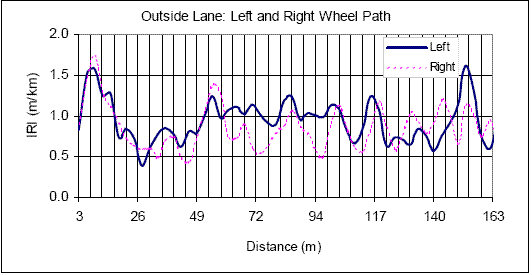
1 m = 3.28 ft
1 m/km =63.4 inches/mi
Figure 80. Roughness profiles for inside lane, left wheel path - S.R. 6220.
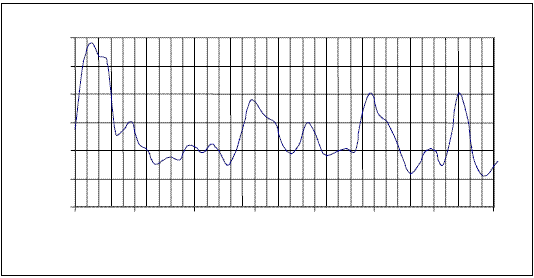
1 m = 3.28 ft
1 m/km =63.4 inches/mi
Figure 81. Roughness profiles for inside lane, right wheel path - S.R. 6220.
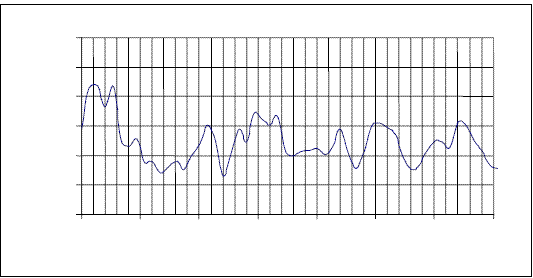
1 m = 3.28 ft
1 m/km =63.4 inches/mi
Figure 82. Roughness profiles for inside lane, left and right wheel path - S.R. 6220.
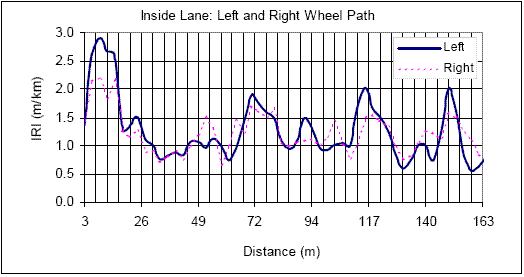
1 m = 3.28 ft
1 m/km =63.4 inches/mi
| Date of Profiling | Approximate Age of Pavement | Time of Profiling | Curvature Index x 1,000 (1/m) | ||
|---|---|---|---|---|---|
| Inside Lane | Outside Lane | ||||
| Left Wheel Path | Right Wheel Path | Left Wheel Path | |||
| 9/18/03 | 1 day | 2:30 to 2:40 p.m. | 0.10 | -0.10 | 0.08 |
| 9/20/03 | 3 days | 1 to 1:40 p.m. | -0.13 | -0.09 | -0.05 |
| 9/24/03 | 7 days | 9:45 to 10 a.m.. | 0.07 | 0.05 | 0.08 |
| 5:05 to 5:35 p.m. | 0.03 | 0.08 | -0.02 | ||
| 10/15/03 | 1 month | 8:40 to 9 a.m. | 0.18 | 0.05 | 0.13 |
| 2:30 to 3 p.m. | 0.16 | -0.02 | 0.02 | ||
| 12/29/03 | 3.5 months | 10 to 11:30 p.m. | 0.05 | -0.09 | -0.03 |
| 3:50 to 4:40 p.m. | 0.07 | -0.10 | -0.02 | ||
1/m = 1/3.28 ft
A CTE test and a microscopical examination were performed on a 150-by-300 mm (5.9-by-11.8 inch) cylinder that was cast from the concrete used in the project. The CTE value for the specimen was 9.60 x 10-6 per oC (5.33 x 10-6 per oF). The microscopical examination identified the coarse aggregate to be primarily dolomite/dolomitic limestone (carbonate) with traces of granite (silicious). The fine aggregate was classified as silicious.
This was a reconstruction project located in Hardin County, IA. This roadway is a four-lane divided highway with two lanes in each direction. A 183-m (600-ft)-long test section was established for testing on the westbound inside lane. The test section was established between stations 1269+00 and 1275+00. (Stations are in U.S. customary units.)
Table 32 presents pavement details. Table 33 presents information about the joints in the pavement.
| Item | Description | Value |
|---|---|---|
| Pavement thickness | Concrete thickness | 260 mm (10.1 inches) |
| Base thickness | 278-mm (10.8-inch) semidrainable Unbound granular base | |
| Pavement width | Total pavement width | 7.8 m (25.6 ft) |
| Width of inside lane | 3.6 m (11.8 ft) | |
| Width of outside lane | 4.2 m (13.8 ft) | |
| Shoulder | Shoulder type | 150-mm (5.9-inch)-thick granular shoulder |
| Width of shoulder | Inside 1.8 m (5.9 ft), outside 2.4 m (7.9 ft) | |
| Joint spacing | Joint spacing | 6 m (19.7 ft) |
| Joints skewed? | Yes, 6:1 | |
| Dowels | Dowel type | Epoxy coated |
| Dowel diameter | 35 mm (1.4 inch) | |
| Dowel length | 457 mm (18 inches) | |
| Tining information | Tining type | Longitudinal tining |
| Tining spacing | 20 mm (0.8 inch) | |
| Tining width | 3 mm (0.12 inch) | |
| Tining depth | 3 mm (0.12 inch) |
| Description | Value |
|---|---|
| Joint formation | Single sawcut using soft cut saw |
| Width of cut | 6 mm (0.24 inch) |
| Depth of cut | 25 ±6 mm (1 ±0.24 inch) |
| Sealant type | Hot-pour bituminous |
| Depth to top of sealant | 6 ±3 mm (0.24 ±0.12 inch) from top of pavement |
Table 34 presents the mix proportions used in the concrete mix. An entrained air admixture and a water-reducing admixture were added to the concrete mix. Table 35 presents the gradation of the aggregates used in the concrete mix.
Table 36 presents the date and time when the test section was paved as well as other details about the paving process. The concrete was placed using a slipform paver. Figure 83 is a photograph of the paving operation. The paver had a super-smoother finishing attachment at the back of the paver for finishing the concrete. More than 25 mm (1 inch) of rain occurred after 8 p.m. on the day paving took place.
| Component | Weight Kilograms per cubic meters (kg/m3 (lb/yd3)) |
|---|---|
| Cement Type 1 | 273 (460) |
| Fly ash; | 48 (81) |
| Coarse aggregate | 844 (1,423) |
| Intermediate aggregate | 281 (474) |
| Sand | 716 (1,207) |
| Sieve | Percentage Passing | ||
|---|---|---|---|
| Coarse Aggregate | Intermediate Alden Limestone | Fine Becker-Brandt Sand | |
| 37.5 mm (1.5 inches) | 100 | 100 | 100 |
| 25.0 mm (1 inch) | 83 | 100 | 100 |
| 19.0 mm (0.75 inch) | 60 | 100 | 100 |
| 12.5 mm (0.5 inch) | 28 | 99 | 100 |
| 9.5 mm (0.4 inch) | 16 | 84 | 100 |
| No. 4 | 2 | 15 | 99 |
| No. 8 | 1 | 2 | 86 |
| No. 16 | 0.9 | 1.8 | 58 |
| No. 30 | - | 1.5 | 28 |
| No. 50 | - | 1.3 | 7.5 |
| No. 100 | - | 1 | 0.9 |
Six sets of profile data were collected over a 3-month period. The pavement was first profiled 1 day after paving, and then the second set of profiles was collected 3 days after paving. The third and fourth sets of data were collected approximately 1 week after paving in the morning and afternoon, respectively. The fifth and sixth sets of data were collected 3 months after paving in the morning and afternoon, respectively, of the same day. The profile data collection was performed using an Ames lightweight profiler that recorded data at 30-mm (1.2-inch) intervals. Table 37 shows the dates and times when profile data collection was performed, the approximate age of the pavement at each of these instances, and the low, high, and mean air temperatures for each profiling day.
A 6-mm (0.25-inch)-wide and 25-mm (1-inch)-deep sawcut had been made on the pavement when the profile data were collected for the first time. The joints were sealed after the 3-day data collection was performed.
| Item | Description | Comment |
|---|---|---|
| Date and time | Date of paving | 5/13/03 |
| Time of paving | 9 a.m. to noon | |
| Paving process | Haul route | Adjacent to inside lane |
| Stringline | 10-m (33-ft) spacing, both sides | |
| Dowels | Fixed to base | |
| Tie bars | Inserted by paver | |
| Concrete deposit method | Belt placers | |
| Spreader used? | Yes, one | |
| Paver | CMI 450B | |
| Concrete | Temperature | 14 oC (57.2 oF) |
| Curing method | Curing compound | White pigmented Conspec white wax - IA |
Figure 83. Paver in operation.
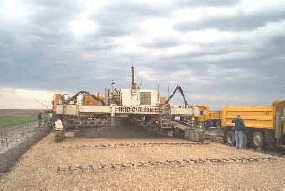
| Date of Profiling | Approximate Age of Pavement | Time of Profiling | Air Temperature oC (oF ) | ||
|---|---|---|---|---|---|
| Low | High | Mean | |||
| 5/14/03 | 1 day | 3 to 4 p.m. | 11 (52) | 21 (70) | 19 (66) |
| 5/16/03 | 3 days | 10 to 10:30 a.m. | 6 (43) | 20 (68) | 13 (55) |
| 5/21/03 | 8 days | 2 to 3 p.m. | 6 (43) | 18 (64) | 12 (54) |
| 5/22/03 | 9 days | 7 to 8 a.m. | 5 (41) | 19 (66) | 12 (54) |
| 8/13/03 | 3 months | 8:30 a.m. | 14 (57) | 28 (82) | 22 (72) |
| 8/13/03 | 3 months | 2 p.m. | |||
The average IRI values computed from the three repeat runs are presented in table 38 and shown in figure 84. Table 39 shows the percentage change in IRI values for different test sequences with respect to the IRI obtained at 1 day.
| Date of Profiling | Approximate Age of Pavement | Time of Profiling | IRI (m/km) | |
|---|---|---|---|---|
| Left Wheel Path | Right Wheel Path | |||
| 5/14/03 | 1 day | 3 to 4 p.m. | 1.18 | 1.65 |
| 5/16/03 | 3 days | 10 to 10:30 a.m. | 1.24 | 1.64 |
| 5/21/03 | 8 days | 2 to 3 p.m. | 1.20 | 1.60 |
| 5/22/03 | 9 days | 7 to 8 a.m. | 1.17 | 1.62 |
| 8/13/03 | 3 months | 8:30 a.m. | 1.20 | 1.48 |
| 8/13/03 | 3 months | 2 p.m. | 1.20 | 1.50 |
Note: Joints were sealed after the 3-day data collection
1 m/km = 63.4 inches/mi
Figure 84. IRI values for different test sequences - U.S. 20.
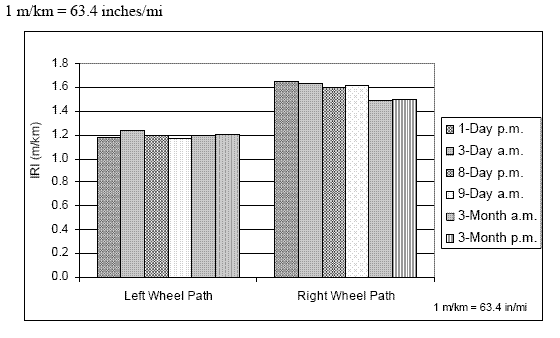
| Date of Profiling | Approximate Age of Pavement | Time of Profiling | Percentage Change in IRI | |
|---|---|---|---|---|
| Left Wheel Path | Right Wheel Path | |||
| 5/16/03 | 3 days | 10 to 10:30 a.m. | 5 | -1 |
| 5/21/03 | 8 days | 2 to 3 p.m. | 2 | -3 |
| 5/22/03 | 9 days | 7 to 8 a.m. | -1 | -2 |
| 8/13/03 | 3 months | 8:30 a.m. | 1 | -10 |
| 8/13/03 | 3 months | 2 p.m. | 2 | -9 |
The following observations were noted when evaluating the IRI values:
The average RN obtained from the three repeat runs are presented in table 40 and shown in figure 85. Table 41 shows the percentage change in RN values for different test sequences with respect to RN obtained at 1 day. The following observations were noted when evaluating the RN values:
| Date of Profiling | Approximate Age of Pavement | Time of Profiling | RN | |
|---|---|---|---|---|
| Left Wheel Path | Right Wheel Path | |||
| 5/14/03 | 1 day | 3 to 4 p.m. | 3.63 | 3.28 |
| 5/16/03 | 3 days | 10 to 10:30 a.m. | 3.59 | 3.27 |
| 5/21/03 | 8 days | 2 to 3 p.m. | 3.69 | 3.36 |
| 5/22/03 | 9 days | 7 to 8 a.m. | 3.72 | 3.34 |
| 8/13/03 | 3 months | 8:30 a.m. | 3.71 | 3.44 |
| 8/13/03 | 3 months | 2 p.m. | 3.74 | 3.45 |
Note: Joints were sealed after the 3-day data collection
Figure 85. RN values for different test sequences to U.S. 20.
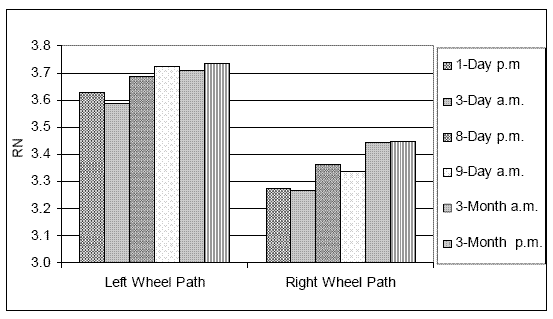
| Date of Profiling | Approximate Age of Pavement | Time of Profiling | IRI (m/km) | |
|---|---|---|---|---|
| Left Wheel Path | Right Wheel Path | |||
| 5/16/03 | 3 days | 10 to 10:30 a.m. | -1 | 0 |
| 5/21/03 | 8 days | 2 to 3 p.m. | 2 | 3 |
| 5/22/03 | 9 days | 7 to 8 a.m. | 3 | 2 |
| 8/13/03 | 3 months | 8:30 a.m. | 2 | 5 |
| 8/13/03 | 3 months | 2 p.m. | 3 | 5 |
On average, when all data sets were considered, the difference between the maximum and minimum IRI values obtained from the three repeat runs was 0.06 m/km (3.8 inches/mi).
The three repeat runs collected along the left wheel path for day-1 testing were used to evaluate the short interval IRI repeatability by comparing IRI values obtained at 15-m (49-ft) intervals. For the 183-m (600-ft)-long section, there are twelve 15-m (49-ft) long segments (the last 3 m (10 ft) of the section was ignored). Figure 86 shows the IRI values obtained at 15-m (49-ft) intervals for the three runs.
An evaluation of the IRI values shown in figure 86 indicates that the IRI values from the different runs were variable for many segments. The difference between the maximum and minimum IRI for each segment obtained from the three repeat runs ranged from a low of 0.02 m/km (2.5 inches/mi) that occurred at segment 6, to a high of 0.60 m/km (38 inches/mi) that occurred at segment 8. The average of the difference between maximum and minimum IRI from the three runs when all segments were considered was 0.25 m/km (16 inches/mi).
The IRI for the entire section obtained from the three repeat runs were very close to each other; the IRI values were 1.66, 1.64, and 1.66 m/km (105, 104, and 105 inches/mi). Although the IRI values for the whole section from the three repeat runs were very close to each other, the distribution of the IRI within the section was very different for the three runs. When the overall IRI for the section is computed, the variations of the IRI within the section for a run are averaged out.
Figure 86. IRI values for repeat runs - U.S. 20.
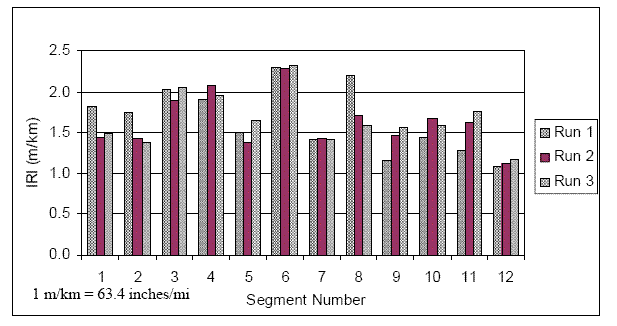
This pavement section has longitudinal tining. When profile data are collected at this type of section, because of lateral variations in the profile path, the laser dot of the height sensor in the profiler can sometimes traverse along the top of the tining and sometimes dip into the tining and collect data at the bottom of the tining. This phenomenon can result in very different data being collected for repeat runs. The high variability in IRI values between the runs when IRI of 15-m (49-ft) segments were considered is attributed to this phenomenon.
The joints were not sealed when the 1-day and 3-day profile data collection was performed. The joints were sealed immediately after the 3-day data collection. Profiles obtained before and after joint sealing were evaluated to investigate how the joints appear on the profile. The left wheel path data collected at 1-day and 1-month afternoon were used in this evaluation.
Figures 87 - 88 show how a typical unsealed and a sealed joint appeared in the profile data. The joint is approximately at a distance of 48 m (157 ft) in the plots. The joint reservoir is 6 mm (0.25 inch) wide. In the unsealed condition, the joint depth was 25 mm (1 inch). When the joint was sealed, the depth to the top of the sealant from the pavement surface was approximately 6 mm (0.25 inch). Although the joint is 6 mm (0.25 inch) wide, the joint appears in the profile as a feature spread over a distance of approximately 300 mm (11.8 inches). The profile plots indicated a depth at a joint of about 2 mm (0.08 inches) and 1 mm (0.04 inches) for the unsealed and sealed condition, respectively.
Figure 87. Measurements at a joint, unsealed - U.S. 20.
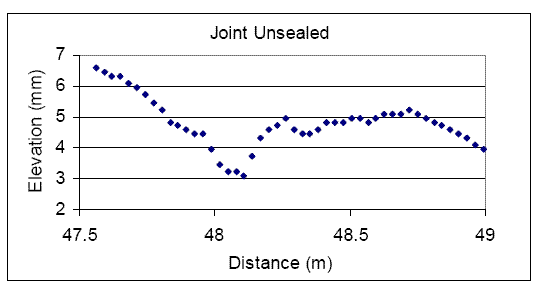
Figure 88. Measurements at a joint, sealed - U.S. 20.
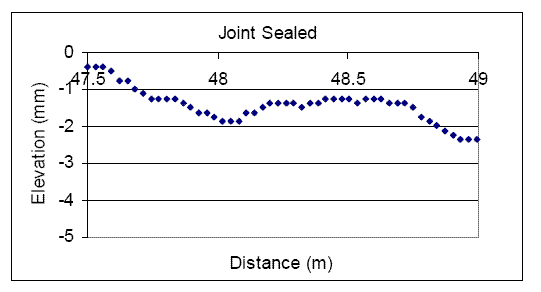
As described previously when discussing joint conditions for the S.R. 6220 project, averaging effects of the height sensor and the anti-alias filter applied on the profile data causes the joint depth to be attenuated as well as the joint to appear as a feature spread over a distance much wider than the actual width of the joint. There is a small difference (approximately 1 mm (0.04 inch)) in the magnitude of the depth of the dip between the unsealed and sealed conditions. However, this difference in magnitude has no effect on IRI; hence, no difference in IRI between the sealed and the unsealed conditions was observed. However, this feature does appear to have a small impact on RN; the RN value increased by 0.1 after the joints were sealed.
The IRI roughness profiles for a 6-m (20-ft) base length for the left wheel path, right wheel path, and an overlaid plot of the two wheel paths obtained from data collected during day-1 testing is shown in figures 89 - 91. The vertical lines in the plots correspond to joint locations.
The roughness profiles show that the roughness of the right wheel path is much higher than that for the left wheel path up to a distance of 128 m (420 ft), but after that the roughness levels of the two wheel paths are close to each other. Some peaks in the roughness profiles, particularly after a distance of 128 m (420 ft) correspond to or are very close to a joint. This phenomenon may indicate a possible effect of dowel baskets on roughness level.
Figure 89. Roughness profiles for U.S. 20, left wheel path.
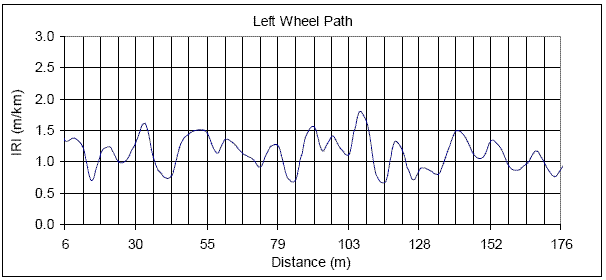
1 m = 3.28 ft
1 m/km = 63.4 inches/mi
Figure 90. Roughness profiles for U.S. 20, right wheel path.
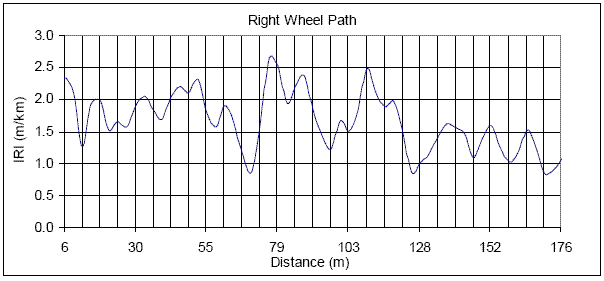
1 m = 3.28 ft
1 m/km = 63.4 inches/mi
Figure 91. Roughness profiles for U.S. 20, left and right wheel path.
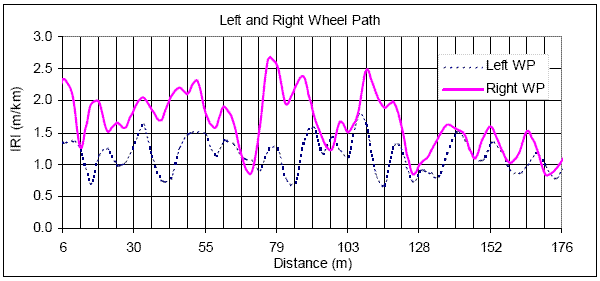
1 m = 3.28 ft
1 m/km = 63.4 inches/mi
An evaluation of the profile data indicated the presence of a repetitive wave in the right wheel path that had an approximate wavelength of 1.6 m (5.2 ft). This wave was not observed in the left wheel path profile. Figure 92 shows a band-pass filtered profile plot of the data collected along the left and the right wheel paths, with the profiles offset for clarity. The right wheel path shows more waviness, which is caused by the repetitive wave.
Figure 92. Band-pass filtered elevation profile.
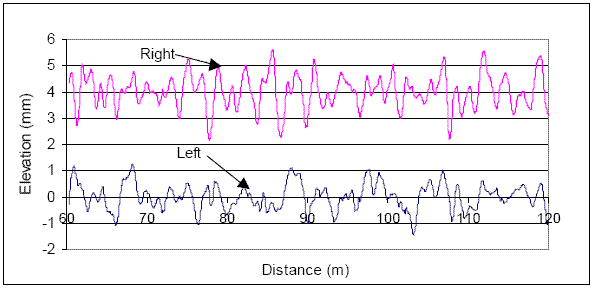
1 m = 3.28 ft
1 mm = 0.039 inch
Figure 93 shows the PSD plot of the left and right wheel path data. The right wheel path profile shows higher roughness between wavenumbers of 0.29 and 2.05 m/cycle (0.95 and 6.7 ft/cycle) compared to the left wheel path. These wavenumbers correspond to wavelengths between 0.5 and 3.5 m (11.5 ft). The cause for the high IRI of the right wheel path compared to the left wheel path is attributed to the higher roughness contribution between these wavelengths. The right wheel path PSD plots shows a peak at wavenumber of 0.65 cycles/m (2.1 cycle/ft), which corresponds to a wavelength of 1.6 m (5.2 ft). This is the dominant repetitive wavelength seen in the right wheel path profile.
The CI value was computed for one profile run from each data set. The computed values are shown in table 42. The CI values obtained for this project were somewhat higher than CI values obtained for the other projects. Some changes in CI were also noted between the data sets. The CI is influenced not only by slab curling that affects the slab over the 6-m (20-ft) slab length, but also other curvature within the slab. For example, for this pavement, the repetitive wave that has a wavelength of 1.6 m (5.2 ft) has a significant effect on CI. Evaluation of the profile data did not indicate much movement in the slabs at the joints for the different data sets. However, changes in slab shapes occurring in other areas between the different data sets contributed to changes in CI between the data sets. Generally, CI for data collected in the afternoon had higher CI values; these values were negative, which indicate downward curvature.
Figure 93. PSD plots of profiles.
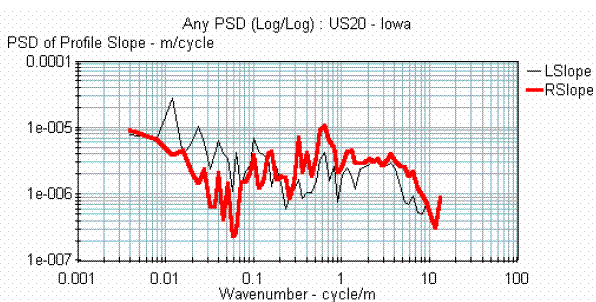
1 m = 3.28 ft
| Date of Profiling | Approximate Age of Pavement | Time of Profiling | Curvature Index x 1,000 (1/m) | |
|---|---|---|---|---|
| Left Wheel Path | Right Wheel Path | |||
| 5/14/03 | 1 day | 3 to 4 p.m. | -0.33 | -0.20 |
| 5/16/03 | 3 days | 10 to 10:30 a.m. | 0.02 | -0.39 |
| 5/21/03 | 8 days | 2 to 3 p.m. | -0.04 | -0.02 |
| 5/22/03 | 9 days | 7 to 8 a.m. | 0.06 | -0.40 |
| 8/13/03 | 3 months | 8:30 a.m. | -0.25 | 0.11 |
| 8/13/03 | 3 months | 2 p.m. | -0.34 | -0.41 |
1/m = 1/3.28 ft
A CTE test conducted on a 100-by-275-mm (4-by-10.8-inch) core indicated a value of 9.83 x 10-6 per oC (5.46 x 10-6 per oF.) A microscopical examination indicated that the coarse aggregate was limestone (carbonate) and the fine aggregate was silicious.
This project was a reconstruction project and is located in Pottawattamie County, IA. This roadway is a four-lane divided highway with two lanes in each direction. A 305-m (1,000-ft)- long test section was established on the eastbound outside lane.
Table 43 presents details of the pavement section. The joint details of this section are similar to those for the U.S. 20 project (see table 33).
Table 44 presents the mix proportions used in the concrete mix. An entrained air admixture and a water-reducing admixture were added to the concrete mix. Table 45 presents the gradation of the aggregates used in the concrete mix.
Table 46 presents the date and time the test section was paved and other details regarding the paving process. The concrete was placed using a slipform paver. Two photographs of the paving process are shown in figures 94 and 95.
Five sets of profile data were collected over a 1-month period. The pavement was first profiled 2 days after paving, and the second set of profiles was collected 3 days after paving. The third and fourth sets of data were collected 1 week after paving in the morning and afternoon, respectively. The fifth set of data was collected 1 month after paving in the afternoon. The profile data collection was performed using an Ames lightweight profiler.
| Item | Description | Value |
|---|---|---|
| Pavement thickness | Concrete thickness | 300 mm (14.8 inches) |
| Base thickness | 260 mm (10.2 inches), semidrainable unbound granular base (crushed concrete) | |
| Pavement width | Total pavement width | 7.8 m (25.6 ft) |
| Width of inside lane | 3.6 m (11.8 ft) | |
| Width of outside lane | 4.2 m (13.8 ft) | |
| Shoulder | Shoulder type | 200 mm (7.8 inches) asphalt |
| Width of shoulder | Inside 1.8 m (5.9 ft), outside 2.4 m (7.9 ft) | |
| Joint spacing | Joint spacing | 6 m (19.7 ft) |
| Joints skewed? | Yes, 6:1 | |
| Dowels | Dowel type | Epoxy coated |
| Dowel diameter | 38 mm (1.5 inches) | |
| Dowel length | 457 mm (17.8 inches) | |
| Tining | Tining type | Longitudinal |
| Tining spacing | 20 mm (0.8 inch) | |
| Tining width | 3 mm (0.1 inch) | |
| Tining depth | 3 mm (0.1 inch) |
| Component | Weight Kilograms per cubic meters (kg/m3 (lb/yd3)) |
|---|---|
| Cement Type IP | 272 (458) |
| Fly ash-Council Bluffs Class C | 48 (81) |
| Coarse aggregate | 870 (1,466) |
| Intermediate/fine | 938 (1,581) |
| Sieve | Percentage Passing | |
|---|---|---|
| Coarse Aggregate | Sand | |
| 37.5 mm (1.5 inches) | 100 | 100 |
| 25.0 mm (1 inch) | 100 | 100 |
| 19 mm (0.75 inch) | 94 | - |
| 12.5 mm (0.5 inch) | 58 | 98 |
| 9.5 mm (0.4 inch) | 26 | 97 |
| No. 4 | 4.3 | 82 |
| No. 8 | 1.4 | 67 |
| No. 16 | - | 53 |
| No. 30 | - | 35 |
| No. 50 | - | 12 |
| No. 100 | - | 0.8 |
| No. 200 | 0.3 | 0 |
| Item | Description | Comment |
|---|---|---|
| Date and time | Date of paving | 10/7/03 |
| Time of paving | Most of the day | |
| Paving process | Haul route | Adjacent to inside lane |
| Stringline | 8-m (26-ft) spacing, both sides | |
| Dowels | Fixed to base | |
| Tie bars | Inserted by paver | |
| Concrete deposit method | Belt placer | |
| Spreader used? | Yes, one | |
| Paver | Guntert & Zimmerman S850 | |
| Concrete | Temperature | 24 oC (75 oF) |
| Curing method | Curing compound | White pigmented Curing compound |
Figure 94. Overall view of the paving train.
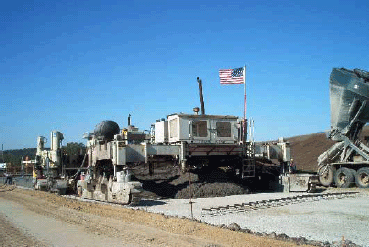
Figure 95. Slipform paver used for paving..
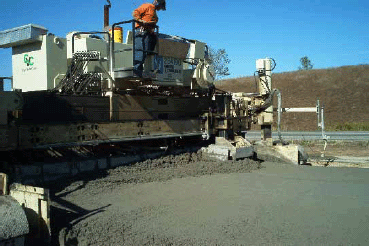
Table 47 shows the dates and times when profile data collection was performed, the approximate age of the pavement at each of these instances, and the low, high, and mean air temperatures for each profiling day.
| Date of Profiling | Approximate Age of Pavement | Time of Profiling | Air Temperature oC (oF ) | ||
|---|---|---|---|---|---|
| Low | High | Mean | |||
| 10/9/03 | 2 days | Morning | 12 (53.6) | 21 (70) | 19 (66) |
| 10/10/03 | 3 days | Morning | 12 (53.6) | 20 (68) | 13 (55) |
| 10/14/03 | 7 days | Morning | 4 (29.2) | 18 (64.4) | 11 (51.8) |
| 7 days | Afternoon. | ||||
| 11/5/03 | 3 months | Afternoon | 14 (57) | 28 (82) | 22 (72) |
The joints had been sealed except for the first 76 m (249 ft) of the test section when the 2-day testing was performed.
The IRI was computed for the entire 304.8-m (1,000-ft)-long test section as well as for each of the two 152.4-m (500-ft)-long sections contained within the section. The average IRI values (computed using values obtained from three runs) are shown in table 48. The IRI values for the 304.8-m (1,000-ft)-long section for the different test sequences are shown in figure 96. Table 49 shows the percentage change in IRI values for different test sequences with respect to IRI obtained from 2-day testing.
| Date of Profiling | Approximate Age of Pavement | Time of Profiling | Ride Number | |||||
|---|---|---|---|---|---|---|---|---|
| Left Wheel Path | Right Wheel Path | |||||||
| Entire Section | First 152.4m (500 ft) | Second 152.4 m (500 ft) | Entire Section | First 152.4 m (500 ft) | Second 152.4 m (500 ft) | |||
| 9/18/03 | 2 days | Morning. | 1.04 | 1.09 | 0.98 | 0.88 | 0.97 | 0.79 |
| 9/20/03 | 3 days | Morning | 1.03 | 1.07 | 0.97 | 0.88 | 0.95 | 0.82 |
| 9/24/03 | 7 days | Morning. | 1.14 | 1.17 | 1.11 | 0.94 | 1.03 | 0.86 |
| 7 days | Afternoon | 1.12 | 1.11 | 1.12 | 0.94 | 1.00 | 0.88 | |
| 10/15/03 | 1 month | Afternoon | 1.11 | 1.23 | 1.01 | 0.93 | 0.99 | 0.87 |
Note: Joints were not sealed in the first 76 m (249 ft) of the section during 2-day profiling. Joints were sealed for all other profiling days.
1 m/km = 63.4 inches/mi
Figure 96. IRI values for different test sequences for entire test section - I-80.
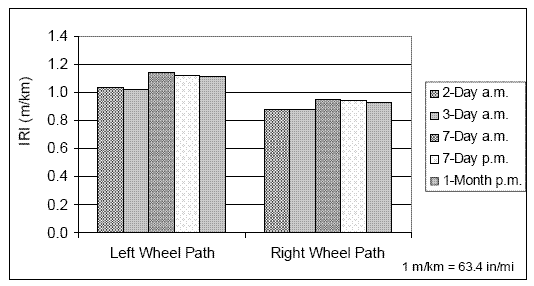
| Approximate Age of Pavement | Time of Profiling | Percentage Change in IRI | |||||
|---|---|---|---|---|---|---|---|
| Left Wheel Path | Right Wheel Path | ||||||
| Entire Section | First 152.4m (500 ft) | Second 152.4 m (500 ft) | Entire Section | First 152.4 m (500 ft) | Second 152.4 m (500 ft) | ||
| 3 days | Morning | -1 | -1 | -1 | 0 | -2 | 3 |
| 7 days | Morning. | 10 | 7 | 14 | 7 | 6 | 9 |
| 7 days | Afternoon | 8 | 2 | 14 | 7 | 3 | 12 |
| 1 month | Afternoon | 7 | 13 | 3 | 6 | 2 | 10 |
The following observations were noted when evaluating the IRI values:
RN was computed for the entire 304.8-m (1,000-ft)-long section, as well as for the two 152.4-m (500-ft)-long sections contained within it. The average RN values are tabulated in table 50. The RN values for the 304.8-m (1,000-ft)-long section for the different test dates and times are shown in figure 97. Table 51 shows the percentage change in RN for different test sequences with respect to RN obtained from 2-day testing.
| Date of Profiling | Approximate Age of Pavement | Time of Profiling | RN | |||||
|---|---|---|---|---|---|---|---|---|
| Left Wheel Path | Right Wheel Path | |||||||
| Entire Section | First 152.4m (500 ft) | Second 152.4 m (500 ft) | Entire Section | First 152.4 m (500 ft) | Second 152.4 m (500 ft) | |||
| 9/18/03 | 2 days | Morning. | 3.79 | 3.70 | 3.90 | 3.94 | 3.85 | 4.04 |
| 9/20/03 | 3 days | Morning | 3.88 | 3.81 | 3.95 | 4.02 | 3.97 | 4.08 |
| 9/24/03 | 7 days | Morning. | 3.74 | 3.69 | 3.79 | 3.96 | 3.92 | 4.01 |
| 7 days | Afternoon | 3.78 | 3.75 | 3.82 | 3.95 | 3.94 | 3.97 | |
| 10/15/03 | 1 month | Afternoon | 3.78 | 3.65 | 3.90 | 3.96 | 3.94 | 4.00 |
Note: Joints were not sealed in the first 76 m (249 ft) of the section during 2-day profiling. Joints were sealed for all other profiling days.
Figure 97. RN values for different test sequences for entire test section - I-80.
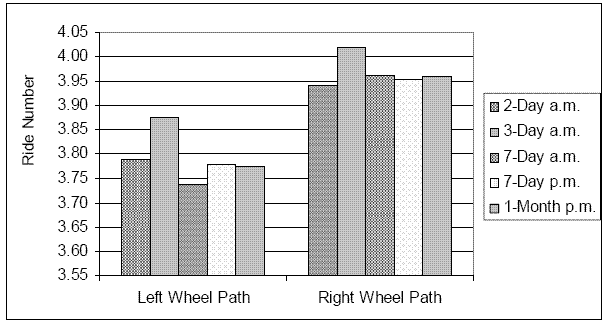
| Date of Profiling | Approximate Age of Pavement | Time of Profiling | Percentage Change in RN | |||||
|---|---|---|---|---|---|---|---|---|
| Left Wheel Path | Right Wheel Path | |||||||
| Entire Section | First 152.4m (500 ft) | Second 152.4 m (500 ft) | Entire Section | First 152.4 m (500 ft) | Second 152.4 m (500 ft) | |||
| 9/20/03 | 3 days | Morning | 2 | 3 | 1 | 2 | 3 | 1 |
| 9/24/03 | 7 days | Morning. | -1 | 0 | -3 | 1 | 2 | -1 |
| 7 days | Afternoon | 0 | 1 | -2 | 0 | 2 | -2 | |
| 10/15/03 | 1 month | Afternoon | 0 | -1 | 0 | 1 | 2 | -1 |
The following observations were noted when evaluating the RN values:
When all profile data sets were considered, the average difference between the maximum and minimum IRI values from the three repeat runs was 0.09 m/km (5.7 inches/mi) when the entire section was considered. When the two 152.4-m (500-ft) sections within the test section were considered individually, this value was 0.11 and 0.12 m/km (7.0 and 7.6 inches/mi) for the first and the second sections, respectively.
The short-interval IRI repeatability was evaluated using the data collected for 2-day testing along the right wheel path. For each run, the IRI values were computed at 15-m (49-ft) intervals to perform this evaluation. For the 304.8-m (1,000-ft)-long section, there are 20 15-m (49-ft)-long segments (the last 4.8 m (16 ft) was omitted). Figure 98 shows the IRI values that were obtained at each 15-m (49-ft)-long segment for the three runs. The IRI values for the segments obtained from the different runs showed high variability for several segments. The difference between the maximum and minimum IRI of the segments obtained from the three repeat runs ranged from a low of 0.07 m/km (4.4 inches/mi) that occurred at segment 16, to a high of 0.27 m/km (17 inches/mi) that occurred at segment 10, with an average value of 0.14 m/km (8.8 inches/mi).
Figure 98. IRI values from repeat runs - I-80.
As in the U.S. 20 project, the IRI for the entire section for the three repeat runs used in this analysis were very close to each other, with the IRI values being 0.91, 0.87, and 0.87 m/km (58, 55, and 55 inches/mi). However, the distribution of the IRI within the section was different for the three runs. The IRI variations tend to compensate for each other when data are averaged over the entire section, and this is the reason why the overall IRI for the three repeat runs were very close to each other, even though the IRI distribution within the section for the three runs showed variability.
This pavement has longitudinal tining similar to the U.S. 20 project. As described for the U.S. 20 project, the variability between runs for short interval IRI in this project is also attributed to the longitudinal tining.
The method used to form joints in this section was similar to that used for the test section in U.S. 20, where joints were formed using a soft cut saw that sawed a joint reservoir 6 mm (0.25 inch) wide and 25.4 mm (1 inch) deep. Profile data collection for this section was performed using the same profiler that collected data at the U.S. 20 test section. The effect of the condition of the joint (sealed versus unsealed) that was seen in the profile data at this test section was similar to the observations noted at the test section located on U.S. 20.
Figures 99 - 101 show IRI roughness profiles based on a 6-m (20-ft) base length for day-3 testing for the left wheel path, right wheel path, and an overlaid plot of the two wheel paths.
Figure 99. Roughness profiles for I-80, left wheel path.
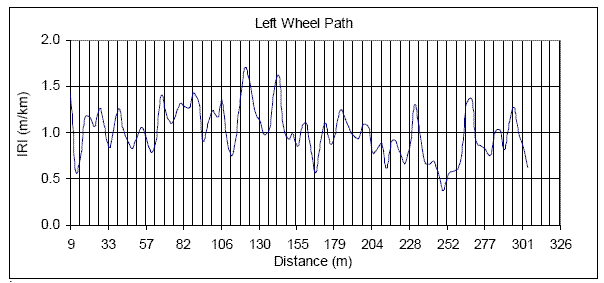
1 m = 3.28 ft 1 m/km = 63.4 inches/mi
Figure 100. Roughness profiles for I-80, right wheel path.
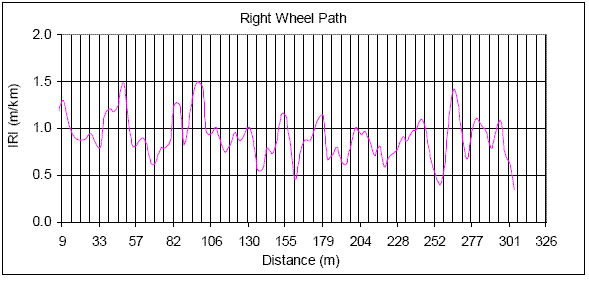
1 m = 3.28 ft 1 m/km = 63.4 inches/mi
Figure 101. Roughness profiles for I-80, left and right wheel path.
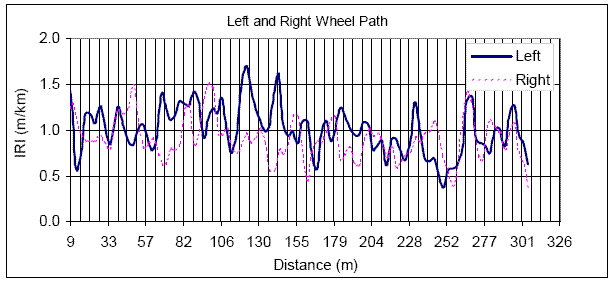
1 m = 3.28 ft 1 m/km = 63.4 inches/mi
The vertical lines in the plots correspond to joint locations. The left wheel path shows a higher roughness level than the right wheel path, particularly for the first 155 m (508 ft) of the section. Except for some localized areas, the 6-m (20-ft) base length IRI along the right wheel path was less than 1 m/km (63 inches/mi). Some peaks in the roughness profiles are coinciding with the joint or are very close to the joint, which may indicate a possible effect of dowel baskets on the roughness.
No differences could be observed in profile data for the different test sequences. In addition, no distinct profile feature or dominant waveband that had a significant influence on the roughness could be identified in the profile data.
The CI value was computed for one profile run from each data set, and the computed values are presented in table 52. These CI values are very small, which indicates that the pavement is essentially in a flat condition. No noticeable changes in curvature have occurred over the monitored period.
| Date of Profiling | Approximate Age of Pavement | Time of Profiling | Curvature Index x 1,000 (1/m) | |
|---|---|---|---|---|
| First 152.4m (500 ft) | Second 152.4 m (500 ft) | |||
| 9/18/03 | 2 days | Morning. | -0.10 | 0.11 |
| 9/20/03 | 3 days | Morning | -0.07 | 0.00 |
| 9/24/03 | 7 days | Morning. | -0.10 | -0.05 |
| 7 days | Afternoon | -0.17 | -0.04 | |
| 10/15/03 | 1 month | Afternoon | 0.02 | -0.11 |
1/m = 1/3.28 ft
A CTE test was conducted on a 100-by-200-mm (4-by-8-inch) cylinder made from the concrete used in this project. The CTE value for the specimen was 13.2 x 10-6 per oC (7.33 x 10-6 per oF). A microscopical examination indicated that the coarse aggregate was quartzite (silicious) and the fine aggregate was silicious.
This project was a reconstruction project located in Monroe County, MI. This roadway is a four-lane divided highway with two lanes in each direction. A 157-m (515-ft)-long test section was established for testing on the two southbound lanes. The test section was established between stations 739+85 and 745+00. (Stations are in U.S. customary units.)
Table 53 provides pavement details. Table 54 presents information about the joints in the pavement.
| Item | Description | Value |
|---|---|---|
| Pavement thickness | Concrete thickness | 280 mm (10.9 inches) |
| Base thickness | 100 mm (4 inches) open-graded aggregate drainage course on 100 mm (4 inches) of dense-graded aggregate base | |
| Pavement width | Total pavement width | 7.9 m (25.9 ft) |
| Width of inside lane | 3.6 m (11.8 ft) | |
| Width of outside lane | 4.3 m (14.1 ft) | |
| Shoulder | Shoulder type | Asphalt |
| Width of shoulder | Inside 1.2 m (3.9 ft), outside 3 m (9.8 ft) | |
| Joint spacing | Joint spacing | 4.6 m (15.1 ft) |
| Joints skewed? | No | |
| Dowels | Dowel type | Epoxy coated |
| Dowel diameter | 32 mm (1.25 inches) | |
| Dowel length | 457 mm (17.8 inches) | |
| Tining | Tining type | Transverse tining |
| Tining spacing | 12.5 mm (0.5 inch) | |
| Tining width | 3 mm (0.12 inch) | |
| Tining depth | 3 to 6 mm (0.12 to 0.23 inch) |
| Description | Value |
|---|---|
| Joint formation | Initial sawcut then reservoir widened |
| Initial sawcut | 3 mm (0.12 inch) wide and 89 mm (3.5 inches) deep |
| Width of cut | 9.5 mm (0.4 inch) |
| Depth of cut | 38 mm (1.5 inches) |
| Sealant type | Neoprene |
| Depth to top of sealant | 6 mm ±1.5 mm (0.25 ±0.06 inch) |
Table 55 presents the mix proportions used in the concrete mix. An air-entraining admixture and a water-reducing admixture were added to the concrete mix. Table 56 presents the gradation of the aggregates used in the concrete mix. The coarse aggregate consisted of a mix of Michigan DOT (MDOT) 4AA and 6AAA limestone aggregate.
| Component | Weight Kilograms per cubic meters (kg/m3 (lb/yd3)) |
|---|---|
| Cement Type 1 | 279 (470) |
| Coarse aggregate-4AA Limestone | 377 (635) |
| Coarse aggregate-6AAA Limestone | 688 (1,160) |
| Sand | 866 (1,460) |
| Sieve | Percentage Passing | |
|---|---|---|
| Coarse Aggregate | Sand | |
| 75 mm (3 inches) | 100 | - |
| 37.5 mm (1.5 inches) | 100 | - |
| 50 mm (2 inches) | 94 | - |
| 37.5 mm (1.5 inches) | 80 | - |
| 25.0 mm (1 inch) | 67 | - |
| 19 mm (0.75 inch) | 49 | - |
| 12.5 mm (0.5 inch) | 17 | - |
| 9.5 mm (0.4 inch) | 8 | 100 |
| No. 4 | 3 | 100 |
| No. 8 | 3 | 85 |
| No. 16 | 3 | 66 |
| No. 30 | 3 | 44 |
| No. 50 | 3 | 18 |
| No. 100 | 3 | 4 |
| No. 200 | - | 1.2 |
Table 57 presents the date and time of paving of the test section as well as other details about the paving process. The paving commenced at 6:30 a.m. and stopped at 11:30 a.m. because rain was predicted later for that day. It started to rain in the afternoon.
Figure 102 shows the view of the base course ahead of the paver and shows the tie bars and dowel baskets placed on the base. Figure 103 shows a view of the paving train used in the project, which consisted of a spreader, slipform paver, and the curing/texturing unit.
| Item | Description | Comment |
|---|---|---|
| Date and time | Date of paving | 8/3/03 |
| Time of paving | 6:30 to 11:30 a.m. | |
| Paving process | Haul route | Adjacent to inside shoulder |
| Stringline | 7.6-m (25-ft) spacing, both sides | |
| Dowels | Fixed to base | |
| Tie bars | Fixed to base | |
| Concrete deposit method | Belt placers | |
| Spreader used? | Yes, one | |
| Curing method | Curing compound | ChemMasters' Safe-Cure 1000TM |
Figure 102. Tie bars and dowel basket placed on base.
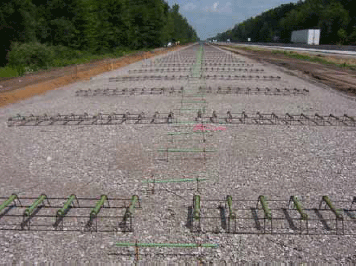
Five sets of profile data were collected at the test section in 2003 within a 10-day period. The profile data were collected using a lightweight profiler that was owned by MDOT, which was using software developed by Transology Association. Figure 104 shows a photograph of the lightweight profiler. This profiler is equipped with a laser height sensor and recorded profile data at 76-mm (3-inch) intervals.
The pavement was first profiled 1 day after paving. Initial sawcuts over joints had been completed a short time before profiling, and dry slurry from the saw-cutting operation was present adjacent to the joints. The second set of data was collected 5 days after paving. The third set of data was collected 9 days after paving in the morning. The joint reservoirs were sawed and unsealed when the profile data were collected. The contractor sealed the joints in the afternoon. The fourth and fifth sets of data were collected on the 10thday after paving in the morning and the afternoon, respectively.
Figure 103. View of the paving train.
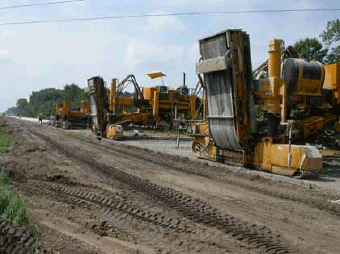
Figure 104. Profile data collection using a lightweight inertial profiler.
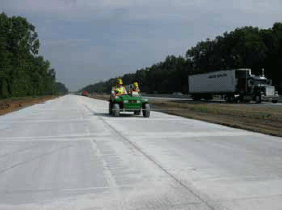
Approximately 1 year after paving, profile data were collected at the test section using a Dynatest high-speed profiler. This profiler is equipped with laser height sensors and recorded profile data at 25-mm (1-inch) intervals. Figure 105 shows a photograph of the Dynatest high-speed profiler.
Figure 105. High-speed inertial profiler.
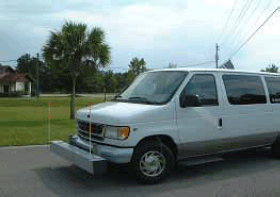
Table 58 presents the dates and times when profile data collection was performed, the approximate age of the pavement at each instance, and the low, high, and mean air temperatures for each data collection date.
| Date of Profiling | Approximate Age of Pavement | Time of Profiling | Air Temperature oC (oF ) | |||||
|---|---|---|---|---|---|---|---|---|
| Inside Lane | Outside Lane | |||||||
| Left Wheel Path | Right Wheel Path | Left Wheel Path | Right Wheel Path | Low | High | Mean | ||
| 8/4/03 | 2 days | 10:33 a.m. | 10:57 a.m. | 10:38 a.m. | 10:48 a.m. | 16 (60) | 27 (80) | 22 (71) |
| 8/8/03 | 5 days | 2:39 p.m. | 12:25 p.m. | 1:03 p.m. | 11:49 a.m. | 19 (66) | 28 (82) | 23 (73) |
| 8/12/03 | 9 days | 10:34 a.m. | 11:11 a.m. | 10:44 a.m. | 10:58 a.m. | 19 (66) | 28 (82) | 24 (75) |
| 8/13/03 | 10 days | 10:47 a.m. | 10:21 a.m. | 10:42 a.m. | 10:05:.am. | 18 (64) | 29 (84) | 24 (75) |
| 3:04 a.m. | 3:34 p.m. | 2:55 p.m. | 4:35 pm. . | |||||
| 8/5/04 | 1 year | 6:30 p.m. | 6:30 p.m. | 6:02 p.m. | 6:02 p.m. | 13 (55) | 23 (73) | 18 (64) |
The average IRI values (computed from the three repeat runs) are presented in table 59 and shown in figure 106. Table 60 shows the percentage change in IRI values for the different test sequences with respect to the IRI obtained at 1 day.
| Date of Profiling | Approximate Age of Pavement | Time of Profiling | Ride Number | |||
|---|---|---|---|---|---|---|
| Inside Lane | Outside Lane | |||||
| Left Wheel Path | Right Wheel Path | Left Wheel Path | Right Wheel Path | |||
| 8/4/03 | 1 day | 10:30 a.m. to 10:50 a.m. | 1.11 | 0.99 | 1.07 | 0.85 |
| 8/8/03 | 5 days | 11:50 a.m. to 2:40 p.m. | 1.01 | 0.83 | 0.81 | 0.79 |
| 8/12/03 | 9 days | 10:35 to 11:15 a.m | 1.03 | 0.99 | 1.10 | 0.84 |
| 8/13/03 | 10 days | 10:05 to 10:50 a.m. | 0.89 | 0.79 | 0.84 | 0.70 |
| 2:55 to 3:55 p.m. | 0.90 | 0.81 | 0.85 | 0.72 | ||
| 8/4/04 | 1 year | 6 to 6:30 p.m. | 0.74 | 0.74 | 0.70 | 0.73 |
Notes:
1 m/km = 63.4 inches/mi
Figure 106. IRI values for different test sequences - U.S. 23.
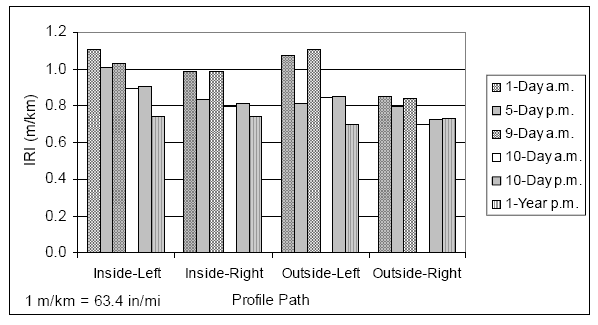
| Date of Profiling | Approximate Age of Pavement | Time of Profiling | Percentage Change in IRI | |||
|---|---|---|---|---|---|---|
| Inside Lane | Outside Lane | |||||
| Left Wheel Path | Right Wheel Path | Left Wheel Path | Right Wheel Path | |||
| 8/8/03 | 5 days | 11:50 a.m. to 2:40 p.m. | -9 | -16 | -24 | -7 |
| 8/12/03 | 9 days | 10:35 to 11:15 a.m | -7 | 0 | 3 | -2 |
| 8/13/03 | 10 days | 10:05 to 10:50 a.m. | -19 | -20 | -21 | -18 |
| 2:55 to 3:55 p.m. | -18 | -17 | -21 | -15 | ||
| 8/4/04 | 1 year | 6 to 6:30 p.m. | -33 | -25 | -35 | -14 |
Notes:
The following observations were noted when evaluating the IRI values:
The average RN values are presented in table 61 and shown in figure 107. Table 62 shows the percentage change in RN values for the different test sequences with respect to the RN obtained at 1 day.
The following observations were noted when evaluating the RN values:
| Date of Profiling | Approximate Age of Pavement | Time of Profiling | Ride Number | |||
|---|---|---|---|---|---|---|
| Inside Lane | Outside Lane | |||||
| Left Wheel Path | Right Wheel Path | Left Wheel Path | Right Wheel Path | |||
| 8/4/03 | 1 day | 10:30 a.m. to 10:50 a.m. | 3.81 | 3.84 | 3.83 | 3.72 |
| 8/8/03 | 5 days | 11:50 a.m. to 2:40 p.m. | 3.86 | 3.93 | 4.06 | 3.87 |
| 8/12/03 | 9 days | 10:35 to 11:15 a.m | 3.00 | 2.86 | 2.88 | 3.10 |
| 8/13/03 | 10 days | 10:05 to 10:50 a.m. | 3.75 | 3.70 | 3.79 | 3.87 |
| 2:55 to 3:55 p.m. | 3.81 | 3.69 | 3.77 | 3.84 | ||
| 8/4/04 | 1 year | 6 to 6:30 p.m. | 3.90 | 3.91 | 3.94 | 3.99 |
Notes:
Figure 107. RN values for different test sequences - U.S. 23..
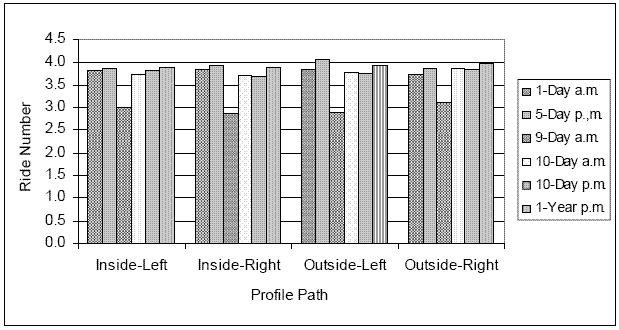
| Date of Profiling | Approximate Age of Pavement | Time of Profiling | Percentage Change in RN with Respect to 1-Day RN (%) | |||
|---|---|---|---|---|---|---|
| Inside Lane | Outside Lane | |||||
| Left Wheel Path | Right Wheel Path | Left Wheel Path | Right Wheel Path | |||
| 8/8/03 | 5 days | 11:50 a.m. to 2:40 p.m. | 1 | 2 | 6 | 4 |
| 8/12/03 | 9 days | 10:35 to 11:15 a.m | -21 | -25 | -25 | -17 |
| 8/13/03 | 10 days | 10:05 to 10:50 a.m. | -2 | -3 | -1 | 4 |
| 2:55 to 3:55 p.m. | 0 | -4 | -2 | 3 | ||
| 8/4/04 | 1 year | 6 to 6:30 p.m. | 2 | 2 | 3 | 7 |
Notes:
When the IRI from three runs for all test sequences were evaluated, the difference between the maximum and the minimum IRI was between 0.01 to 0.11 m/km (0.6 to 7.0 inch/mi), with the average difference being 0.06 m/km (3.8 inches/mi).
An evaluation of the repeatability of short-interval IRI was performed by computing IRI at 15-m (49-ft) intervals for the three repeat runs collected along the left wheel path of the inside lane for the day-10 morning runs. For the 156-m (512-ft)-long section, there are 10 15-m (49-ft) long segments (the last 6 m (20 ft) of the section were not considered). Figure 108 shows the IRI values that were obtained at 15-m (49-ft) intervals for each run for each segment.
Figure 108. Repeatability of IRI values - U.S. 23.
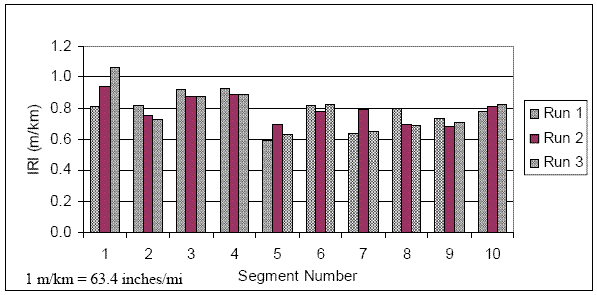
A few sections had significant differences in IRI values between runs. The difference between the maximum and minimum IRI for each segment obtained from the three repeat runs ranged from a low of 0.04 m/km (2.5 inches/mi) that occurred at segment 4, to a high of 0.25 m/km (15.6 inches/mi) that occurred at segment 1, with an average 0.10 m/km (6.3 inches/mi). The IRI values obtained from the three runs for the entire section were 0.79, 0.80, and 0.79 m/km (50, 51, and 50 inches/mi). Significant differences in IRI were shown for repeat runs at a few 15-m (49-ft) segments. However, when IRI of the entire section from the three runs was compared, the three values were almost identical. As described previously for the other projects, this result is caused by compensating effects.
During this study, the lightweight profiler collected profile data when the joints were in the following conditions:
The data collected under these three conditions were evaluated to investigate how the joints showed up on the profile. Data collected along the left wheel path of the outside lane were used in this investigation. Figures 109 - 111 show how a typical joint appeared on the profile for each of these conditions. The joint is located between 35 and 35.5 m (114.8 and 116.4 ft). Note the following observations for each case shown in figures 109 - 111:
Figure 109. Measurement at a joint, initial sawcut - U.S. 23.
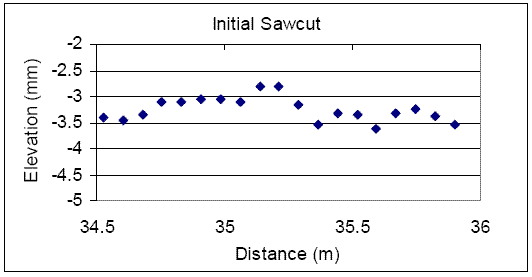
1 m = 3.28 ft
1 mm = 0.039 inch
Figure 110. Measurement at a joint, joint reservoir widened - U.S. 23.
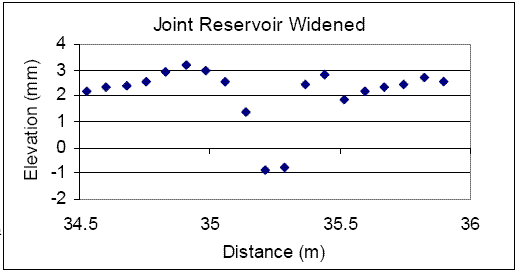
1 m = 3.28 ft
1 mm = 0.039 inch
Figure 111. Measurement at a joint, joint sealed - U.S. 23.
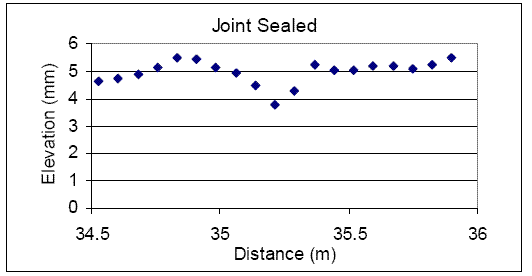
1 m = 3.28 ft
1 mm = 0.039 inch
An evaluation of IRI values shown in table 59 shows that IRI obtained after the joints were sealed was lower than that obtained when the joint reservoir was sawed but the joint not sealed. IRI decreased after the joint was sealed because the lower depth of the joint is recorded in the profile.
As described previously for the other projects, the averaging performed on the height sensor data and the anti-alias filter applied on the profile data cause the depth of the joint to be attenuated. In addition, these factors cause the joint to appear in the profile data as a feature spread over a much wider distance than the actual width of the joint. The actual width of the joint in this case is 9.5 mm (0.4 inch), but the joint appears in the profile as a dip that is spread over a distance of 450 mm (17.7 inches). The depth of the joint reservoir is 38 mm (1.5 inches) and when sealed the depth to the top of the sealant from the pavement surface according to the specification should be 6 mm (0.25 inch). The depths noted for these two cases in the profile were approximately 4 and 1.5 mm (0.16 and 0.06 inch), respectively.
The 1-year data at this section were collected using a Dynatest high-speed profiler. The locations of the joints were clearly visible in the data collected by this profiler. Figure 112 shows the data that were typically collected by this profiler at a joint. The joint is located between 3.5 and 3.6 m (11.5 and 11.8 ft).
Figure 112. Data collected over a joint by the high-speed profiler.
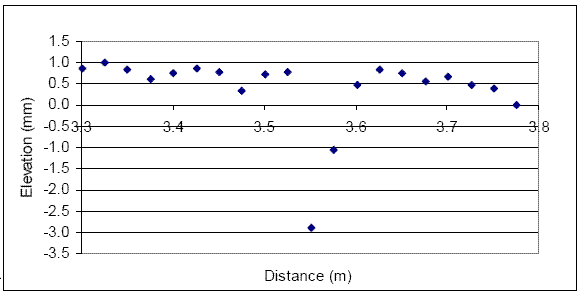
1 m = 3.28 ft
1 mm = 0.039 inch
The 6-m (20-ft) base length IRI roughness profiles for the day-10 morning data for the inside and outside lanes are shown in figures 113 - 118, respectively. In each roughness profile, the vertical lines correspond to a joint location.
As seen in figures 113 - 115, several localized rough spots were along both wheel paths of the inside lane. The roughness at these localized locations was not excessive, except in the left wheel path of the inside lane, where there was a noticeable rough spot at about 35 m (115 ft). Figures 116 - 118 shows that in the outside lane, the first 16 m (49 ft) of the left wheel path has a higher roughness compared to the rest of the left wheel path and the right wheel path. In the outside lane apart from the first 16 m (49 ft) of the left wheel path, the left and right wheel paths show a close roughness distribution along the section.
An evaluation of profile data collected at different time sequences indicated that the profiles obtained at day 1 were different from the other profiles because they showed a small hump around each joint. Figure 119 shows how the humps appeared in the profile. The profile data collection at day 1 was performed immediately after the joints were sawed, and residue from the sawing operation was present adjacent to the joint. Figure 120 shows a photograph of the pavement that was obtained at the time profiling was performed at day 1. The humps seen in the profile appear to have been caused by the residue from the sawing operation. These humps were not noticeable for data collected after day-1 profiling because the residue would have been washed from the rain experienced after profiling. The decrease in IRI after day-1 profiling is attributed to elimination of these humps from the profile.
Figure 113. Roughness profiles for inside lane, left wheel path - U.S. 23.
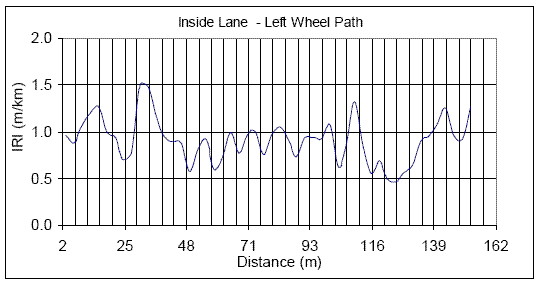
1 m = 3.28 ft 1 m/km = 63.4 inches/mi
Figure 114. Roughness profiles for inside lane, right wheel path - U.S. 23.
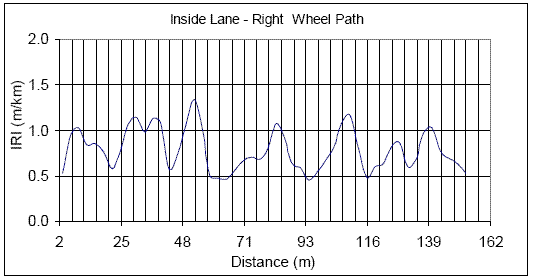
1 m = 3.28 ft 1 m/km = 63.4 inches/mi
Figure 115. Roughness profiles for inside lane, left and right wheel path - U.S. 23..
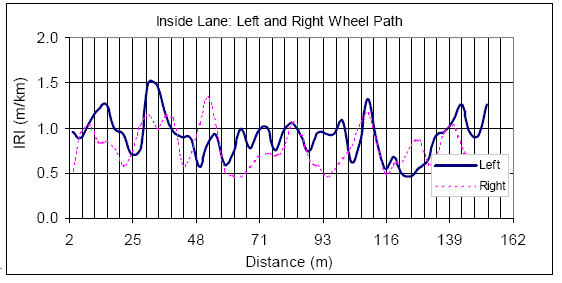
1 m = 3.28 ft 1 m/km = 63.4 inches/mi
Figure 116. Roughness profiles for outside lane, left wheel path - U.S. 23.
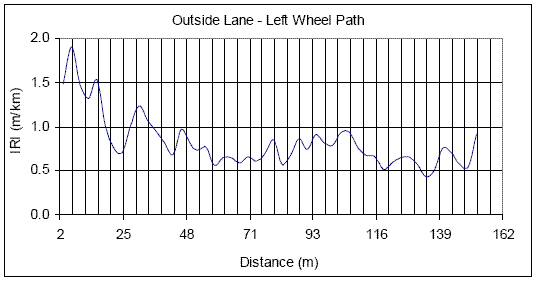
1 m = 3.28 ft 1 m/km = 63.4 inches/mi
Figure 117. Roughness profiles for outside lane, right wheel path - U.S. 23.
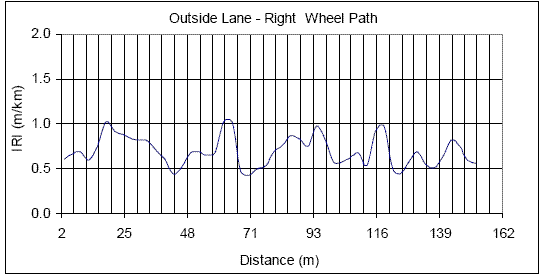
1 m = 3.28 ft 1 m/km = 63.4 inches/mi
Figure 118. Roughness profiles for outside lane, left and right wheel path - U.S. 23.
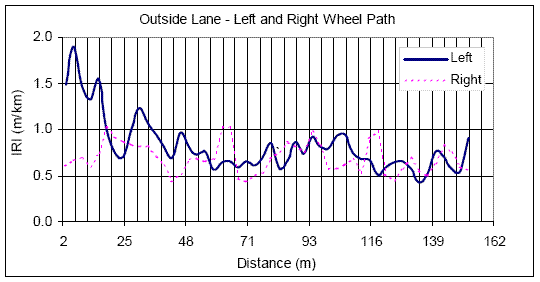
1 m = 3.28 ft 1 m/km = 63.4 inches/mi
Figure 119. Humps in profile for 1-day profile data.
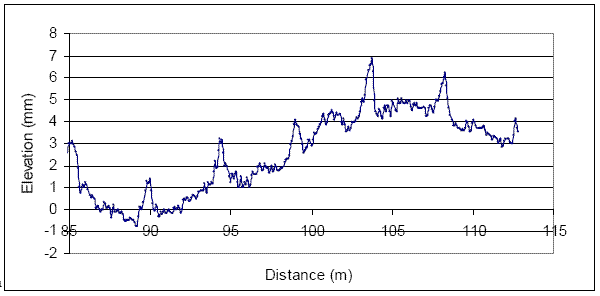
1 m = 3.28 ft 1 m/km = 63.4 inches/mi
Figure 120. Residue from joint sawing operation adjacent to a joint.
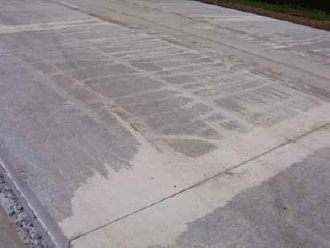
IRI obtained from 1-year profiling (data collected by high-speed profiler) was lower than IRI obtained from day-10 profiling (data collected by lightweight profiler). There were some differences in these two profile data sets, but no distinct profile feature that caused the differences in IRI to occur could be identified. Analysis of the data collected over the joints indicated these two profilers have different averaging and/or low-pass filtering methods. It is not clear whether the reduction in IRI was related to changes in the pavement profile or to differences between the profiling equipment.
CI was computed for one profile run from each data set, and the computed values are shown in table 63. These CI values are very small indicating the pavement is essentially in a flat condition. No noticeable changes in curvature have occurred over the monitored period.
| Date of Profiling | Approximate Age of Pavement | Time of Profiling | Percentage Change in RN with Respect to 1-Day RN (%) | ||
|---|---|---|---|---|---|
| Inside Lane | Outside Lane | ||||
| Right Wheel Path | Left Wheel Path | Right Wheel Path | |||
| 8/4/03 | 1 day | 10:30 .to 10:50 a.m. | 0.07 | 0.13 | 0.07 |
| 8/8/03 | 5 days | 11:50 a.m. to 2:40 p.m. | 0.00 | -0..07 | 0.01 |
| 8/12/03 | 9 days | 10:35 to 11:15 a.m | 0.12 | -0.16 | -0.17 |
| 8/13/03 | 10 days | 10:05 to 10:50 a.m. | -0.02 | -0.16 | -0.10 |
| 2:55 to 3:55 p.m. | -0.08 | -0.16 | -0.11 | ||
| 8/4/04 | 1 year | 6 to 6:30 p.m. | -0.01 | -0.26 | 0.18 |
1/m = 1/3.28 ft
The core obtained from this pavement was lost in the mail when it was shipped to the laboratory to perform the CTE test. Hence, a CTE value is not available for the concrete used in this project.
This project was a reconstruction project located in Calhoun County, MI. This roadway is a four-lane divided highway with two lanes in each direction. A 148-m (485-ft)-long test section was established for testing on the inside lane in the southbound direction. The test section was established between stations 1450+84 and 1445+97. (Stations are in U.S. customary units.)
Table 64 presents details regarding the pavement. The joint details in this project were similar to those used in the U.S. 23 project (see table 54).
| Item | Description | Value |
|---|---|---|
| Pavement thickness | Concrete thickness | 280 mm (10.9 inches) |
| Pavement width | Total pavement width | 7.9 m (25.9 ft) |
| Width of inside lane | 3.6 m (11.8 ft) | |
| Width of outside lane | 4.3 m (14.1 ft) | |
| Shoulder | Shoulder type | Asphalt |
| Joint spacing | Joint spacing | 4.6 m (15.1 ft) |
| Joints skewed? | No | |
| Dowels | Dowel type | Epoxy coated |
| Dowel diameter | 32 mm (1.25 inches) | |
| Dowel length | 457 mm (17.8 inches) | |
| Tining | Tining type | Transverse tining |
| Tining spacing | 12.5 mm (0.5 inch) | |
| Tining width | 3 mm (0.12 inch) | |
| Tining depth | 3 to 6 mm (0.12 to 0.23 inch) |
Table 65 presents the mix proportions that were used in the concrete mix. Table 66 presents the gradation of the aggregates used in the concrete mix.
| Component | Weight Kilograms per cubic meters (kg/m3 (lb/yd3)) |
|---|---|
| Cement | 237 (400) |
| Fly ash | 42 (71) |
| Coarse aggregate | 1071 (1,805) |
| Sand | 838 (1,412) |
| Sieve | Percentage Passing | |
|---|---|---|
| Coarse Aggregate | Sand | |
| 62.5 mm (2.4 inches) | 100 | 100 |
| 50 mm (2 inches) | 97.7 | 100 |
| 37.5 mm (1.5 inches) | 77.5 | 100 |
| 25.0 mm (1 inch) | 62.3 | 100 |
| 19 mm (0.75 inch) | 52.6 | 100 |
| 12.5 mm (0.5 inch) | 28.3 | 100 |
| 9.5 mm (0.4 inch) | 16.4 | 100 |
| No. 4 | 2.8 | 99.4 |
| No. 8 | 1.3 | 89.2 |
| No. 16 | 1 | 67.8 |
| No. 30 | 1 | 39.5 |
Table 67 presents the date and time the test sections were paved and other details about the paving process. The paving for that day began at 6 a.m. and stopped at noon because rain was predicted later for that day. It started to rain in the afternoon. The test section was observed to have had less than ideal (probably less than specified) tining depth, which was probably the result of the rain that occurred in the afternoon. Figure 121 shows a photograph of the front view of the paver and figure 122 shows a photograph of the finishing process behind the paver.
| Item | Description | Comment |
|---|---|---|
| Date and time | Date of paving | 7/8/03 |
| Time of paving | 6 a.m. to noon | |
| Paving process | Haul route | Adjacent to inside shoulder |
| Stringline | 7.6-m (25-ft) spacing, both sides | |
| Dowels | Inserted by paver | |
| Tie bars | Inserted by paver | |
| Concrete deposit method | Deposited by trucks in front of paver | |
| Spreader used? | No | |
| Curing method | Curing compound | White curing compound |
Figure 121. View from the front of the paver.
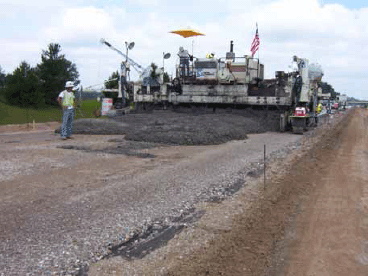
Four sets of profile data were collected within a 10-day period with a lightweight profiler that is owned by MDOT. This profiler uses software provided by Transology Association. The data recording interval in the profiler is 76 mm (3 inches). The pavement was first profiled 1 day after paving. Initial sawcuts over joints had just been completed before the runs were made. Wet slurry from the saw-cutting operation was present on the pavement adjacent to the joints when
the pavement was profiled. The second set of profiles was collected 6 days after paving. The third and fourth sets of data were collected on the 10th day; separate data sets were collected in the morning and in the afternoon. After the morning runs were made, and before performing the afternoon runs, the contractor widened the initial sawcut to create the reservoir for placing the joint sealant. Day-10 afternoon profiles were obtained when the joints were in this condition.
Figure 122. Finishing process behind the paver..
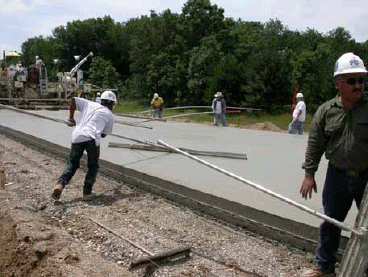
About 4.5 months after paving, this section was profiled again with the high-speed profiler owned by MDOT. Table 68 presents the dates and times when data collection was performed, the approximate age of the pavement at each of these instances, and the low, high, and mean air temperature for each data collection date.
| Date of Profiling | Approximate Age of Pavement | Time of Profiling | Air Temperature oC (oF ) | |||
|---|---|---|---|---|---|---|
| Left Wheel Path | Right Wheel Path | Low | High | Mean | ||
| 7/9/03 | 1 day | 11:41 a.m. | 11:53 a.m. | 17 (62) | 26 (78) | 16 (60) |
| 7/14/0 | 6 days | 11:27 a.m. | 11:53 a.m. | 12 (53) | 28 (82) | 21 (69) |
| 7/18/03 | 10 days | 9:18 a.m. | 9:34 a.m. | 13 (55) | 26 (78) | 19 (66) |
| 3:54 p.m. | 3:47 p.m. | |||||
| 11/26/03 | 4.5 months | 12:10 p.m. | 12:10 p.m. | -2 (28) | 8 (46) | 3 (37) |
The average IRI values (computed by averaging data obtained from repeat runs) are tabulated in table 69 and shown in figure 123. Table 70 shows the percentage change in IRI values for the different test sequences with respect to the IRI obtained at 1 day.
| Date of Profiling | Approximate Age of Pavement | Time of Profiling | IRI (m/km) | |
|---|---|---|---|---|
| Left Wheel Path | Right Wheel Path | |||
| 7/9/03 | 1 day | 11:40 to 11:55 a.m. | 1.15 | 1.17 |
| 7/14/03 | 6 days | 11:25 to 11:55 a.m. | 1.05 | 1.12 |
| 7/18/03 | 10 days | 9:15 to 9:35 a.m. | 1.09 | 1.04 |
| 10 days | 3:45 to 3:55 p.m. | 1.29 | 1.48 | |
| 7/9/03 | 4.5 months | 12:10 p.m. | 1.25 | 1.43 |
Notes:
Figure 123. IRI values for different test sequences - I-69.
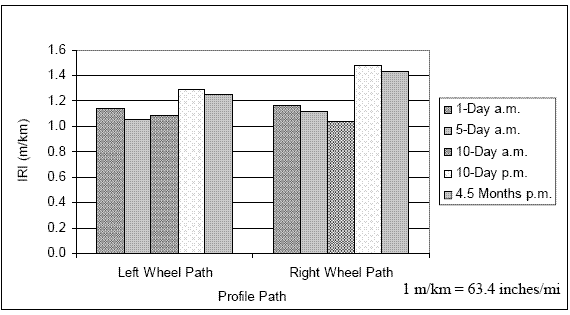
| Date of Profiling | Approximate Age of Pavement | Time of Profiling | Percentage Change in IRI | |
|---|---|---|---|---|
| Left Wheel Path | Right Wheel Path | |||
| 7/14/03 | 6 days | 11:25 to 11:55 a.m. | 2 | 2 |
| 7/18/03 | 10 days | 9:15 to 9:35 a.m. | 4 | 7 |
| 10 days | 3:45 to 3:55 p.m. | -21 | -30 | |
| 7/9/03 | 4.5 months | 12:10 p.m. | -4 | -6 |
Notes:
The following observations were noted when evaluating the IRI values:
The average RN values (computed by averaging values of the three repeat runs) are presented in table 71 and shown in figure 124. Table 72 shows the percentage change in RN values for the different test sequences with respect to the RN obtained at 1 day.
| Date of Profiling | Approximate Age of Pavement | Time of Profiling | Ride Number | |
|---|---|---|---|---|
| Left Wheel Path | Right Wheel Path | |||
| 7/9/03 | 1 day | 11:40 to 11:55 a.m. | 3.66 | 3.66 |
| 7/14/03 | 6 days | 11:25 to 11:55 a.m. | 3.73 | 3.74 |
| 7/18/03 | 10 days | 9:15 to 9:35 a.m. | 3.81 | 3.91 |
| 10 days | 3:45 to 3:55 p.m. | 2.87 | 2.58 | |
| 7/9/03 | 4.5 months | 12:10 p.m. | 3.50 | 3.45 |
Notes:
Figure 124. RN values for different test sequences - I-69.
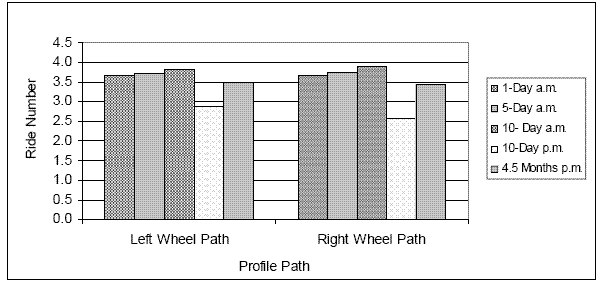
| Date of Profiling | Approximate Age of Pavement | Time of Profiling | Percentage Change in RN | |
|---|---|---|---|---|
| Left Wheel Path | Right Wheel Path | |||
| 7/14/03 | 6 days | 11:25 to 11:55 a.m. | -8 | -4 |
| 7/18/03 | 10 days | 9:15 to 9:35 a.m. | -5 | -11 |
| 10 days | 3:45 to 3:55 p.m. | 13 | 27 | |
| 7/9/03 | 4.5 months | 12:10 p.m. | 9 | 22 |
Notes:
The following observations were noted when evaluating the RN values:
When the IRI values obtained for the entire section from all profile sequences for the lightweight profiler were compared, the difference between the maximum and minimum IRI for the three runs ranged between 0.01 to 0.10 m/km (6.3 inches/mi), with the average difference of 0.04 m/km (2.5 inches/mi).
An evaluation of the short-interval IRI repeatability of the lightweight profiler was performed by computing IRI values at 15-m (49-ft) intervals for day-9 morning right wheel path data. For the 148-m (485-ft)-long test section, there are nine 15-m (49-ft)-long segments. Figure 125 shows the IRI values that were obtained at 15-m (49-ft) intervals for each run for each segment. Overall, the repeatability appeared to be satisfactory for most segments, but a few segments had significant differences in IRI values between runs. The difference between the maximum and minimum IRI for each segment obtained form the three repeat runs ranged from a low of 0.06 m/km (3.8 inches/mi) at segment 3, to a high of 0.24 m/km (15.2 inches/mi) at segment 1. The average of the difference between maximum and minimum IRI from the three runs for the segments was 0.11 m/km (7 inches/mi). The IRI values obtained from the three runs for the entire section were 1.04, 1.03, and 1.06 m/km (66, 65, and 67 inches/mi). Although there were differences in individual 15-m (49-ft) segments between runs, when the overall IRI of the entire section from the three runs were compared, the three values were almost identical. As described previously for the other projects, this closeness occurs because of compensating effects of IRI over the section.
Figure 125. Repeatability of IRI values - I-69.
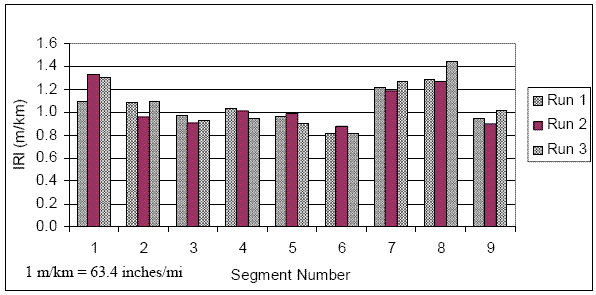
The method used to form joints in this section was similar to that used for the test section on U.S. 23. Profile data collection for this section was performed using the same profiler that collected data at the U.S. 23 test section. The effect of joints seen in the profile data at this test section was similar to the observations noted at the test section located on U.S. 23.
Figures 126 - 128 show the 6-m (20-ft) base length roughness profile for the section. The vertical lines in the plots correspond to joint locations. These roughness profiles are for data that were collected at 9 days after paving in the morning. The IRI values of the entire section for the two wheel paths for that test date were extremely close to each other: IRI of the left and the right wheel paths were 1.09 and 1.04 m/km (67 and 66 inches/mi), respectively. Although the overall roughness values for the two wheel paths are close to each other, the roughness profiles shown in figures 126 - 128 show that the variability of roughness within the section is greater for the left wheel path. Along the left wheel path, the roughness profile exceeded 1.5 m/km (95 inches/mi) at five locations compared to one location for the right wheel path.
Five profile data sets were obtained at this test section. The first four data sets were obtained with a lightweight profiler; the last data set was obtained with a high-speed profiler. There were significant differences in the spatial distribution of roughness within the section obtained by the two profilers. Hence, it is unclear whether the differences in IRI noted between the 4.5-month profiling and 1-day profiling were caused by a difference in the pavement profile, or whether they were related to differences between the two profilers' data collection capabilities. As was indicated previously, when profile data collection was performed with the high-speed profiler, a median barrier was present between the lanes. Hence, the high-speed profiler may not have been able to follow the exact path that was profiled by the lightweight profiler. This is another factor that could have contributed to differences in IRI obtained by the high-speed profiler and the lightweight profiler.
An evaluation of the profile data did not indicate a distinct profile feature or a waveband that had a dominant contribution to IRI.
CI was computed for one profile run from each data set, and the computed values are presented in table 73. All CI values are small, which indicates that the PCC slabs are essentially in a flat condition with negligible curvature. No noticeable changes in curvature were noted between the different data sets.
Figure 126. Roughness profiles for I-69, left wheel path.
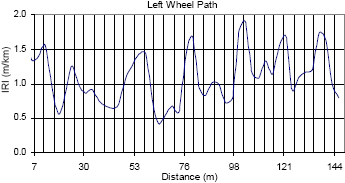
1 m = 3.28 ft 1 m/km = 63.4 inches/mi
Figure 127. Roughness profiles for I-69, right wheel path.
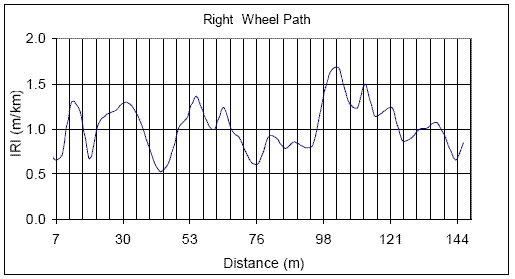
1 m = 3.28 ft 1 m/km = 63.4 inches/mi
Figure 128. Roughness profiles for I-69, left and right wheel path.
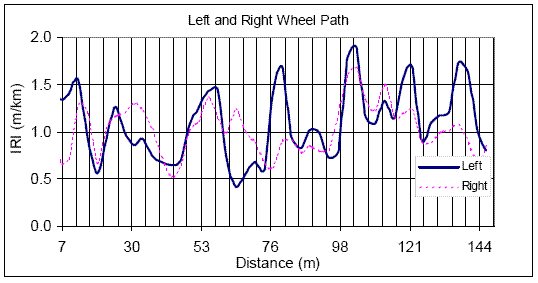
1 m = 3.28 ft 1 m/km = 63.4 inches/mi
| Date of Profiling | Approximate Age of Pavement | Time of Profiling | Curvature Index x 1,000 (1/m) | |
|---|---|---|---|---|
| Left Wheel Path | Right Wheel Path | |||
| 7/9/03 | 1 day | 11:40 to 11:55 a.m. | 0.049 | 0.184 |
| 7/14/03 | 6 days | 11:25 to 11:55 a.m. | 0.187 | 0.194 |
| 7/18/03 | 10 days | 9:15 to 9:35 a.m. | 0.082 | 0.062 |
| 10 days | 3:45 to 3:55 p.m. | 0.095 | 0.125 | |
| 7/9/03 | 4.5 months | 12:10 p.m. | 0.000 | 0.127 |
A CTE test was conducted on a 150-by-300-mm (5.9-by-11.8-inch) core from the pavement. The CTE value for the specimen was 8.25 x 10-6 per oC (4.58 x 10-6 per oF). A microscopical examination of the core indicated that the coarse aggregate was dolomite/dolomitic limestone (carbonate) and the fine aggregate was silicious.